武汉大学分子生物学试卷
分子生物学考研真题汇编
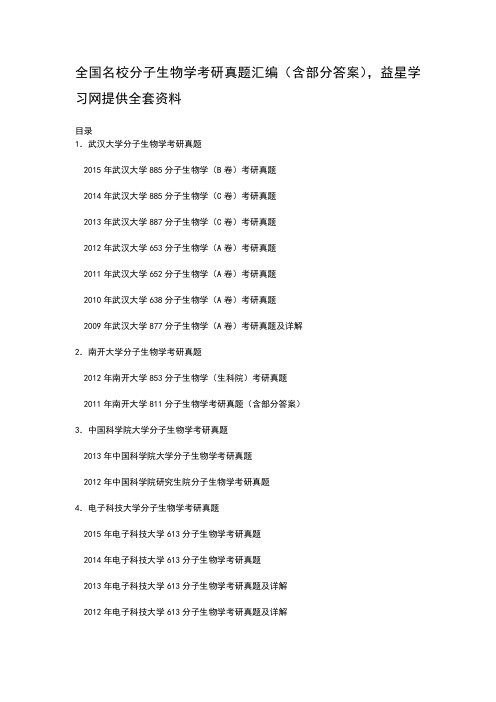
全国名校分子生物学考研真题汇编(含部分答案),益星学习网提供全套资料目录1.武汉大学分子生物学考研真题2015年武汉大学885分子生物学(B卷)考研真题2014年武汉大学885分子生物学(C卷)考研真题2013年武汉大学887分子生物学(C卷)考研真题2012年武汉大学653分子生物学(A卷)考研真题2011年武汉大学652分子生物学(A卷)考研真题2010年武汉大学638分子生物学(A卷)考研真题2009年武汉大学877分子生物学(A卷)考研真题及详解2.南开大学分子生物学考研真题2012年南开大学853分子生物学(生科院)考研真题2011年南开大学811分子生物学考研真题(含部分答案)3.中国科学院大学分子生物学考研真题2013年中国科学院大学分子生物学考研真题2012年中国科学院研究生院分子生物学考研真题4.电子科技大学分子生物学考研真题2015年电子科技大学613分子生物学考研真题2014年电子科技大学613分子生物学考研真题2013年电子科技大学613分子生物学考研真题及详解2012年电子科技大学613分子生物学考研真题及详解2011年电子科技大学613分子生物学考研真题及详解5.河北大学分子生物学考研真题2014年河北大学878分子生物学(重点实验室)A考研真题2013年河北大学878分子生物学(重点实验室)A考研真题2012年河北大学878分子生物学(重点实验室)考研真题6.暨南大学分子生物学考研真题2015年暨南大学836分子生物学考研真题2014年暨南大学836分子生物学考研真题7.武汉科技大学分子生物学考研真题2015年武汉科技大学616分子生物学(B卷)考研真题及详解2014年武汉科技大学616分子生物学(B卷)考研真题及详解8.其他名校分子生物学考研真题2015年浙江工业大学653分子生物学考研真题2015年宁波大学941分子生物学(A卷)考研真题2014年重庆大学627分子生物学考研真题2013年深圳大学717分子生物考研真题2012年南京航空航天大学865分子生物学(A卷)考研真题2012年军事医学科学院分子生物学考研真题2011年南京大学834分子生物学(A卷)考研真题。
分子生物学试题(附答案)
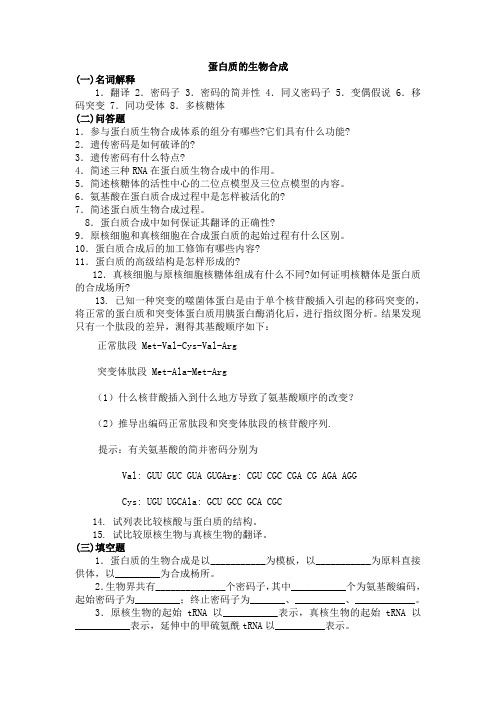
蛋白质的生物合成(一)名词解释1.翻译 2.密码子 3.密码的简并性 4.同义密码子 5.变偶假说 6.移码突变 7.同功受体 8.多核糖体(二)问答题1.参与蛋白质生物合成体系的组分有哪些?它们具有什么功能?2.遗传密码是如何破译的?3.遗传密码有什么特点?4.简述三种RNA在蛋白质生物合成中的作用。
5.简述核糖体的活性中心的二位点模型及三位点模型的内容。
6.氨基酸在蛋白质合成过程中是怎样被活化的?7.简述蛋白质生物合成过程。
8.蛋白质合成中如何保证其翻译的正确性?9.原核细胞和真核细胞在合成蛋白质的起始过程有什么区别。
10.蛋白质合成后的加工修饰有哪些内容?11.蛋白质的高级结构是怎样形成的?12.真核细胞与原核细胞核糖体组成有什么不同?如何证明核糖体是蛋白质的合成场所?13. 已知一种突变的噬菌体蛋白是由于单个核苷酸插入引起的移码突变的,将正常的蛋白质和突变体蛋白质用胰蛋白酶消化后,进行指纹图分析。
结果发现只有一个肽段的差异,测得其基酸顺序如下:正常肽段 Met-Val-Cys-Val-Arg突变体肽段 Met-Ala-Met-Arg(1)什么核苷酸插入到什么地方导致了氨基酸顺序的改变?(2)推导出编码正常肽段和突变体肽段的核苷酸序列.提示:有关氨基酸的简并密码分别为Val: GUU GUC GUA GUGArg: CGU CGC CGA CG AGA AGGCys: UGU UGCAla: GCU GCC GCA CGC14. 试列表比较核酸与蛋白质的结构。
15. 试比较原核生物与真核生物的翻译。
(三)填空题1.蛋白质的生物合成是以___________为模板,以___________为原料直接供体,以_________为合成杨所。
2.生物界共有______________个密码子,其中___________个为氨基酸编码,起始密码子为_________;终止密码子为_______、__________、____________。
2022武汉大学分子生物学真题

2022武汉大学分子生物学真题一、名词解释1、Ribozyme核酶2、MieneMutation错义突变3、Inulator绝缘子4、RNAtran-plicingRNA反式剪接5、Nucleotidee某ciionrepair 核苷酸切除修复6、Tranpoon转座子7、Dammethylae甲基化酶8、pliceoome剪接体9、corepromoter核心启动子10、SNP单核苷酸多态性二、简答题1、请简述真核生物mRNA的5’帽结构有何生物学功能?其缺失会造成什么后果?2、某一基因开放阅读框中的一个碱基突变会对该基因编码产物产生怎样的影响?3、请简述真核生物的mRNA和原核生物的mRNA有何不同。
4、请简述Ⅰ型内含子剪切过程。
ORF中单个碱基改变对基因表达产物的影响5、简述Weternblot的原理和步骤。
三、论述题1、研究基因功能通常是降低或者升高基因表达水平,请简要说出三种相关研究方法及原理。
2、mRNA和蛋白质的降解是一个有序的过程,其中microRNA和泛素起了非常重要的作用。
请阐述microRNA的概念、产生过程、作用机制,或者泛素的概念和蛋白质泛素化的过程。
(二者只需选择一种进行阐述)3、某实验需要将1kb的cDNA片段插入某氨苄青霉素抗性的表达载体,在片段两端各有一个EcoRl位点,靠近5’端300bp的地方有一EcoRv位点,载体多克隆位点从5’端依次为BamHl,Hindllll,EcoRl,EcoRv和某hol位点。
实验设计步骤如下:(1)用EcoRl处理载体,然后用碱性磷酸酶处理。
(2)用EcoRl处理片段,然后与步骤(1)中的载体混合,加入DNA连接酶,在适当的条件下使cDNA片段与载体连接。
(3)连接产物转化到大肠杆菌,并在含有氨苄青霉素的LB平板上生长。
除此之外,还设了以下对照:对照1:在含有抗生素的平板上涂布未被转化的大肠杆菌感受态细胞。
对照2:用未被酶切处理的载体转化大肠杆菌感受态细胞,并在含有抗生素的平板上生长。
2001-2013年武汉大学分子生物学研究生入学考试真题

武汉大学2001年攻读硕士学位研究生入学考试试题科目名称:分子生物学科目代码: 477一、解释概念(20分,每个4分)卫星DNA 复制体逆转座子反式激活因子衰减子与衰减作用二、填空(30分,每空1分,请将答案写在答卷上)1. 从病毒到高等生物的研究表明,遗传物质是。
2. 冈崎片段的发现证实了双链DNA的复制,在复制过程中,一条新生链的合成是的,称为链;而另一条链的合成是的,称为链。
3. 大肠菌中有三种DNA聚合酶,其中的pol I的作用是,而pol III的作用是。
pol I和pol III都有的三种活性是、、。
4.由于真核细胞染色体DNA的复制要有一段RNA为引物,因此线状的DN A复制后必须存在着5’端缩短的问题。
已发现有一种端粒蛋白称为,它由构成,可以使单链DNA的5’延长。
5. 对DNA损伤有几种修复系统,其中只有修复系统可以造成DNA变异,与这一系统有关的一套基因平时受到一称为的抑制蛋白所抑制,它发挥抑制作用是结合在一段约20bp长的称为的DNA序列上,当DNA损伤时,另一种蛋白质称为把这种抑制蛋白水解后,修复系统的基因才会被激活。
6.真核细胞中有三种依赖于DNA的RNA聚合酶分别合成不同的RNA,RNA pol I负责合成,RNA pol II负责合成,RNA pol III负责合成。
7.大分子互相作用是分子生物学的重要内容,包括蛋白质之间、蛋白质与DNA或RNA之间的互相作用,蛋白质有四种重要的结构花式与大分子互相作用有关,这些结构花式是, , 。
8. NO是气体小分子信号,它可由脱氨产生,它的作用方式是直接与酶作用使产生cGMP(环式GMP)。
9. 真核mRNA的5’ 端通常有帽子结构,3’ 端有polyA。
在polyA上游有一保守序列称为polyA信号,其序列为。
polyA能提高mRNA的翻译水平是由于:(1) (2) 。
10. G-蛋白关联受体是一类重要的细胞表面受体,它的结构特色是,它发挥信号传递作用的两条途径是途径和途径。
分子生物学试题及答案

分子生物学试题及答案一、单项选择题(每题2分,共20分)1. DNA分子的双螺旋结构是由谁提出的?A. 沃森和克里克B. 达尔文C. 孟德尔D. 摩尔根答案:A2. 以下哪个不是DNA聚合酶的功能?A. 合成DNA链B. 修复DNA损伤C. 催化RNA转录D. 校对新合成的DNA链答案:C3. 真核生物的mRNA帽子结构位于其5'端,其主要功能是什么?A. 促进翻译B. 保护mRNA不被降解C. 促进mRNA的剪接D. 促进mRNA的运输答案:B4. 以下哪种RNA分子在蛋白质合成中不直接参与?A. mRNAB. tRNAC. rRNAD. snRNA5. 基因表达调控中,转录因子的作用是什么?A. 提供转录所需的能量B. 识别并结合到特定的DNA序列上C. 催化DNA复制D. 促进DNA修复答案:B6. 以下哪种技术用于研究基因功能?A. PCRB. DNA测序C. 基因敲除D. DNA指纹分析答案:C7. 以下哪个不是DNA复制的特点?A. 半保留复制B. 需要引物C. 双向复制D. 需要逆转录酶答案:D8. 以下哪个不是RNA干扰(RNAi)的作用机制?A. 降解特定的mRNAB. 抑制基因表达C. 促进基因突变D. 沉默特定基因答案:C9. 以下哪个是真核生物中常见的非编码RNA?B. siRNAC. tRNAD. rRNA答案:A10. 以下哪个是原核生物和真核生物共有的基因表达调控机制?A. 转录后修饰B. 转录因子调控C. mRNA剪接D. 核糖体结合位点调控答案:B二、填空题(每空1分,共20分)1. DNA分子的基本组成单位是_______,而RNA分子的基本组成单位是_______。
答案:脱氧核苷酸;核糖核苷酸2. 在DNA复制过程中,_______酶负责解开双链DNA,而_______酶负责合成新的DNA链。
答案:解旋酶;DNA聚合酶3. 真核生物的基因表达调控主要发生在_______水平,而原核生物的基因表达调控主要发生在_______水平。
分子生物学试题(附答案)
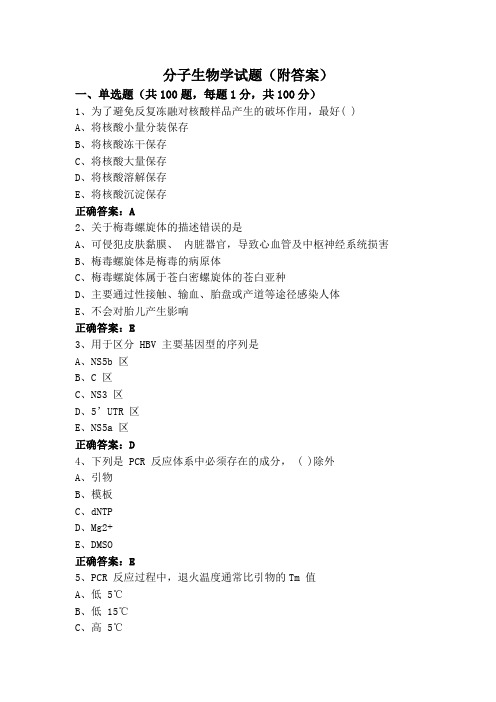
分子生物学试题(附答案)一、单选题(共100题,每题1分,共100分)1、为了避免反复冻融对核酸样品产生的破坏作用,最好( )A、将核酸小量分装保存B、将核酸冻干保存C、将核酸大量保存D、将核酸溶解保存E、将核酸沉淀保存正确答案:A2、关于梅毒螺旋体的描述错误的是A、可侵犯皮肤黏膜、内脏器官,导致心血管及中枢神经系统损害B、梅毒螺旋体是梅毒的病原体C、梅毒螺旋体属于苍白密螺旋体的苍白亚种D、主要通过性接触、输血、胎盘或产道等途径感染人体E、不会对胎儿产生影响正确答案:E3、用于区分 HBV 主要基因型的序列是A、NS5b 区B、C 区C、NS3 区D、5’UTR 区E、NS5a 区正确答案:D4、下列是 PCR 反应体系中必须存在的成分, ( )除外A、引物B、模板C、dNTPD、Mg2+E、DMSO正确答案:E5、PCR 反应过程中,退火温度通常比引物的Tm 值A、低5℃B、低15℃C、高5℃D、高15℃E、相等正确答案:A6、关于 DNA 芯片描述不正确的是A、探针为已知序列B、有序地高密度地固定于支持物上C、理论基础是核酸杂交D、可研究基因序列E、不能研究基因突变正确答案:E7、硝酸纤维素膜最大的优点是( )A、高结合力B、本底低C、非共价键结合D、共价键结合E、脆性大正确答案:B8、下列物质不适于非放射性探针标记的是A、AKPB、ACPC、生物素D、地高辛E、荧光素正确答案:B9、检测 TB 的实验室技术中,被认为是目前最先进的一种检测TB 及其耐药性的方法是A、PCR 技术B、荧光定量 PCR 技术C、PCR-RFLP 技术D、全自动结核杆菌检测技术E、DNA 测序技术正确答案:D10、目前最常用的TB 分子检测方法是A、PCRB、real-time PCRC、SDAD、LPAE、DNA chip正确答案:B11、DNA 指纹分子的遗传性基础是A、连锁不平衡B、MHC 的多样性C、DNA 的多态性D、反向重复序列E、MHC 的限制性正确答案:C12、基因芯片原位合成的描述错误的是A、直接在芯片上用四种核苷酸合成所需探针B、适用于寡核苷酸探针C、适用于制作大规模 DNA 探针芯片D、可实现高密度芯片的标准化和规模化生产E、也称为离片合成正确答案:E13、个体识别所使用的 HLA 分型技术不包括下列哪项 ( )A、PCR-RFLPB、PCR-SSPC、PCR-SSOPD、PCR-指纹图E、FISH正确答案:E14、美国食品药品监督管理局规定用于检测尿液标本中淋病奈瑟菌的方法是A、革兰染色镜检B、抗酸染色镜检C、淋病奈瑟菌 16SrRNA 基因检查D、ELISAE、动物接种正确答案:C15、操纵子结构不存在于:A、大肠杆菌基因组中B、真核生物基因组中C、细菌基因组中D、原核生物基因组中E、病毒基因组中正确答案:B16、脆性 X 综合征的临床表现有A、智力低下伴眼距宽、鼻梁塌陷、通贯手、指间距宽B、智力正常、身材矮小、肘外翻、乳腺发育差、乳间距宽C、智力低下伴头皮缺损、多指、严重唇裂及膊裂D、智力正常张力亢进,特殊握拳姿势、摇椅足E、智力低下伴长脸、大耳朵、大下颌、大睾丸正确答案:A17、稀有碱基主要存在于A、核糖体 RNAB、信使 RNAC、转运 RNAD、核 DNAE、线粒体 DNA正确答案:C18、当标本核酸量非常低难以扩增时,可采用的 PCR 技术是A、逆转录 PCRB、转录介导扩增C、原位 PCRD、巢式 PCRE、荧光 PCR正确答案:D19、单基因遗传病诊断最重要的前提是A、了解患者的家族史B、疾病表型于基因关系已阐明C、了解相关基因的基因克隆和功能分析等知识D、进行个体的基因分型E、了解相关基因的染色体定位正确答案:A20、次氯酸钠去除临床分子生物学实验室污染源的原理是A、诱导同一 DNA 链上相邻的两个嘧啶之间形成嘧啶二聚体B、氧化损伤核酸C、水解核酸D、与扩增产物的嘧啶碱基形成单加成环丁烷衍生物E、与胞嘧啶形成羟氨基胞嘧啶正确答案:B21、PCR 反应体系不包括A、耐热的 TaqDNA 聚合酶B、cDNA 探针C、4 种 dNTPD、合适的缓冲液体系E、模板 DNA正确答案:B22、阴性质控品失控的原因不包括A、扩增产物污染B、标本交叉污染C、放射性污染D、基因组 DNA 或质粒的污染E、试剂污染正确答案:C23、第三代测序技术的最主要特征:A、对单分子 DNA 进行非 PCR 的测序B、对 SNP 进行非 PCR 的测序C、高通量和并行 PCR 测序D、直接分析 SNPE、直接进行个体基因组测序和 SNP 研究正确答案:A24、下列方法中能同时检测几种疟原虫混合感染的是A、竞争 PCRB、巢式 PCRC、多重 PCRD、普通 PCRE、PCR-RFLP正确答案:C25、目前,个体识别和亲子鉴定主要依靠A、STR 基因座技术B、PCR-SSOC、蛋白质凝胶电泳技术D、PCR-SSCPE、细胞混合培养技术正确答案:A26、分离纯化核酸的原则是 ( )A、保证一定浓度B、保持一级结构完整并保证纯度C、保持二级结构完整并保证纯度D、保持空间结构完整E、保证纯度与浓度正确答案:B27、未来基因诊断的主要发展方向是A、胎盘着床前诊断B、母体外周血中胎儿细胞分析技术C、对常见病进行分子诊断D、对多发病进行分子诊断E、以上都是正确答案:E28、关于人工合成的寡核苷酸探针,下列描述不正确的是A、特异性高B、可依赖氨基酸序列推测其序列C、分子量小D、可用于相似基因顺序差异性分析E、可用末端转移酶进行5’端标记正确答案:E29、SDS 是一种阴离子表面活性剂,其可断开蛋白质分子内和分子间的( )A、氢键B、离子键C、二硫键D、酯键E、疏水键正确答案:A30、基因芯片技术的本质是 ( ) :A、核酸分子杂交B、蛋白质分子杂交技术C、连接酶链反应D、DNA 重组技术E、酶切技术正确答案:A31、关于点样法进行 DNA 芯片制备不正确的是A、直接在芯片上用四种核苷酸合成所需探针的 DNA 芯片制备技术B、通过高速点样机直接点样C、多用于大片段 DNA 探针的芯片制备D、成本低E、速度快正确答案:A32、DNA 自动化测序技术一般用不到的技术是A、Sanger 的双脱氧链终止法B、Maxam 和 Gilbert 的化学降解法C、荧光标记技术D、PCR 技术E、电泳技术正确答案:B33、关于肿瘤分子诊断的说法正确的是A、肿瘤分子诊断就是利用分子生物学原理和技术建立的肿瘤诊断方法B、肿瘤的分子诊断中根据目的、对象、类型的不同要采取相似的诊断策略与方法C、肿瘤分子诊断的研究成果仅用于临床肿瘤的诊断D、肿瘤分子诊断的核心是基于细胞水平的分子诊断技术E、肿瘤分子诊断的含义主要表现在虽然检测对象众多,但大多数标志物是特异性的肿瘤标志物正确答案:A34、实时荧光 PCR 中,GC 含量在 20%~80% (45%~55%最佳) ,单链引物的最适长度为A、35~50bpB、15~20bpC、55~70bpD、5~20bpE、70~90bp正确答案:B35、线粒体病分子生物学检验标志物不包括A、点突变位点B、重复序列C、SNP 位点D、缺失或插入片段E、线粒体单体型正确答案:B36、线粒体基因组编码几种rRNAA、22 种B、20 种C、18 种D、3 种E、2 种正确答案:E37、基因诊断间接方法不包括A、基于 SNP 的单倍型分析B、Southern blotC、基于 STR 的微卫星分析D、PCR-RFLPE、RFLP 连锁分析正确答案:B38、下列方法中不属于 RNA 诊断的是A、Northern blotB、RNA 斑点杂交C、基因芯片D、mRNA 差异显示 PCR 技术E、逆转录 PCR正确答案:C39、在对病原体检测中,一次性获得信息量最大的技术是 ( )A、ELISAB、荧光定量 PCR 技术C、PCR-RFLP 技术D、原位杂交技术E、基因芯片技术正确答案:E40、生物芯片根据芯片上固定的探针种类不同可分为几种,不包括:A、DNA 芯片B、蛋白质芯片C、细胞芯片D、组织芯片E、测序芯片正确答案:E41、以下不需要对引物或探针预先标记的实时定量 PCR 方法是A、TaqMan 水解探针技术B、探针杂交技术C、分子信标技术D、SYBR Green Ⅰ荧光染料技术E、数字 PCR 技术正确答案:D42、关于带正电荷尼龙膜的描述下列不正确的是A、可结合 DNAB、可结合 RNAC、对盐浓度要求不高D、核酸可通过 UV 交联共价结合E、本底较低正确答案:E43、可作为分子遗传标记的是A、HLAB、单拷贝序列C、高表达蛋白D、RFLPE、染色体正确答案:D44、下列关于人类遗传病的叙述不正确的是A、人类遗传病包括单基因遗传病、多基因遗传病和染色体异常遗传病B、21-三体综合症患者体细胞中染色体数目为 47 条C、单基因病是指受一个基因控制的疾病D、遗传性疾病既可以直接诊断,也可以间接诊断E、人类遗传病是指由于遗传物质改变而引起的疾病正确答案:C45、乙型肝炎病毒的核酸类型是 ( )A、双股 DNAB、负股 DNAC、正股 DNAD、单股 DNAE、DNA-RNA 二聚体正确答案:A46、目前白血病的发病机制的研究主要集中的领域不包括A、融合基因与白血病B、遗传学疾病及白血病发病的后天因素C、基因多态性与白血病D、白血病复发的后天因素E、白血病发病的先天因素正确答案:D47、镰状细胞贫血患者,代替其血红蛋白β链 N 端第六个氨基酸残基谷氨酸的是A、苯丙氨酸B、缬氨酸C、酪氨酸D、丙氨酸E、丝氨酸正确答案:B48、多重 PCR 的描述中正确的是:A、同一个模板,多种不同的引物B、相同的引物,多种不同的模板C、多个模板,多种引物D、引物的Tm 值、反应时间和温度、反应缓冲液等尽量不一致以区分不同产物E、同一反应内各扩增产物片段的大小应尽可能相同或接近正确答案:A49、GeneXpert 全自动结核杆菌检测技术现可进行哪种药物的耐药检测A、乙胺丁醇B、吡嗪酰胺C、异烟肼D、链霉素E、利福平正确答案:E50、目前确认与人类肿瘤发生有关的RNA 病毒是A、人乳头状瘤病毒B、乙型肝炎病毒C、EB 病毒D、人类疱疹病毒-8E、丙型肝炎病毒正确答案:E51、编码 HIV 衣壳蛋白的是A、tat 基因B、gag 基因C、env 基因D、vif 基因E、pol 基因正确答案:B52、下列不属于 SNP 检测技术特点的是 ( )A、遗传稳定性B、富有代表性C、密度低D、密度高E、易实现分析的自动化正确答案:C53、下列哪些技术不适用于鉴定菌种亲缘性:A、随机扩增DNA 多态性分析B、连接酶链反应C、PCR-RFLPD、多位点测序分型E、DNA 测序技术正确答案:B54、珠蛋白基因的碱基由G 突变为 C 时,造成的突变称为A、密码子缺失或插入B、单个碱基置换C、融合基因D、移码突变E、片段缺失正确答案:B55、HCV 基因分型的“金标准”是( )A、基因分型检测芯片B、测序分析法C、实时荧光 PCRD、基因型特异性引物扩增法E、RFLP正确答案:B56、核酸探针不可用什么标记A、放射性核素标记B、抗体标记C、生物素标记D、荧光标记E、地高辛标记正确答案:B57、第二代测序技术最主要技术特征是A、对单分子 DNA 进行非 PCR 的测序B、针对 SNP 进行非 PCR 的测序C、高通量和并行 PCR 测序D、直接分析 SNPE、直接进行个体基因组测序和 SNP 研究正确答案:C58、关于 Ct 值的描述,不正确的是A、Ct值是荧光定量 PCR 获得的最初数据资料B、Ct代表了反应达到预定设置的阈值时的循环次数C、Ct 与反应模板的初始模板量成正比D、Ct越小代表其模板核酸拷贝数越多E、Ct值处于扩增曲线和荧光本底基线的交叉点正确答案:C59、提取 DNA 的原则除外A、保证核酸一级结构完整性B、保留所有核酸分子C、核酸样本中不应存在有机溶剂和过高浓度的金属离子D、蛋白质、多糖和脂类分子的污染应降低到最低程度E、排除 RNA 分子的污染与干扰正确答案:B60、硝酸纤维素和PVDF 膜结合蛋白主要靠( )A、疏水作用B、氢键作用C、离子键作用D、盐键作用E、酯键作用正确答案:A61、以 mRNA 为模板合成 cDNA 的酶是A、DNA 酶B、Taq DNA 聚合酶C、限制性内切酶D、RNA 酶E、逆转录酶正确答案:E62、HIV 核酸类型是:A、单链 DNAB、双链 DNAC、单正链 RNAD、单正链 RNA 双聚体E、单负链 RNA正确答案:D63、采用了所谓酶联级联测序技术的测序方法是A、边合成边测序B、化学降解法测序C、双脱氧终止法测序D、焦磷酸测序E、寡连测序正确答案:D64、线粒体基因突变不包括A、mtDNA 拷贝数的变异B、碱基突变C、插入D、缺失E、重复序列增多或减少正确答案:E65、HIV 核酸类型是A、单链 DNAB、双链 DNAC、单正链 RNAD、单正链 RNA 双聚体E、单负链 RNA正确答案:D66、研究得最早的核酸分子杂交种类是( )A、菌落杂交B、Northern 杂交C、Southern 杂交D、液相杂交E、原位杂交正确答案:D67、PCR 中的脱氧核苷三磷酸不包括A、dATPB、dTTPC、dCTPD、dGTPE、dUTP正确答案:E68、PCR 反应的基本过程不包括A、预变性B、退火C、淬火D、变性E、延伸正确答案:C69、表达谱芯片A、是在 DNA 水平研究基因之间的表达关系B、是在 mRNA 水平研究基因之间的表达关系C、是在蛋白质水平研究基因之间的表达关系D、不能用于疾病机制的研究E、不能指导个体化治疗正确答案:B70、杂交时的温度与错配率有关,错配率每增加 1%,则 Tm 值下降A、1~1.5℃B、3~3.5℃C、0.5℃D、4~4.5℃E、2~2.5℃正确答案:A71、关于荧光原位杂交技术叙述不正确的是( )A、用荧光素标记探针B、用放射性核素标记探针C、无需经过核酸的提取D、可以用于遗传病的产前诊断E、可以用于基因定位正确答案:B72、以下不是在移植配型中常用的分子生物学检测技术是A、核酸分子杂交技术B、PCR 技术C、基因芯片技术D、免疫组化技术E、基因测序技术正确答案:D73、大多数质粒在自然状态下是( )A、线性双链 DNAB、线性单链 DNAC、线性单链 RNAD、环状双链 DNAE、环状单链 DNA正确答案:D74、珠蛋白生成障碍性贫血的主要原因是A、珠蛋白基因突变导致氨基酸序列改变B、血红蛋白破坏加速C、出现异常血红蛋白 SD、铁代谢异常E、珠蛋白链合成速率降低正确答案:E75、关于分子信标技术的描述,不正确的是A、分子信标设计简单B、操作简便C、背景信号低D、特异性强E、灵敏度高正确答案:A76、下述序列中,在双链状态下属于完全回文结构的序列是A、AGTCCTGAB、AGTCAGTCC、AGTCGACTD、GACTCTGAE、ACTCGACT正确答案:C77、PCR 反应的基本过程不包括以下:A、预变性B、退火C、探针杂交D、变性E、延伸正确答案:C78、最容易降解的核酸探针是A、cDNA 探针B、dsDNA 探针C、ssDNA 探针D、gDNA 探针E、RNA 探针正确答案:E79、Southern 杂交通常是指( )A、DNA 与 RNA 杂交B、DNA 与 DNA 杂交C、RNA 与 RNA 杂交D、蛋白质与蛋白质杂交E、DNA 与蛋白质杂交正确答案:B80、不属于移植配型中常用的分子生物学检测技术是 ( )A、RFLP/PCR-RFLP/PCR-SSPB、PCR-SSCPC、PCR-SequencingD、PCR-SSO/基因芯片技术E、FISH正确答案:E81、不是自动 DNA 测序仪主要系统之一的是A、测序反应系统B、电泳系统C、荧光检测系统D、探针荧光标记系统E、电脑分析系统正确答案:D82、下列关于Taq DNA 聚合酶的描述,错误的是A、以 dNTPs 为原料B、催化形成3’,5’-磷酸二酯键C、使 DNA 链沿5’→3’方向延伸D、不具有3’→5’外切酶活性E、扩增的DNA 片段越长,碱基错配率越低正确答案:E83、关于 RNA 探针的描述下列不正确的是A、可用于随机引物标记B、特异性高C、灵敏度高D、可用非同位素标记法标记E、不易降解正确答案:E84、关于mtDNA 的描述正确的是A、结构基因编码 mtDNA 复制所需的酶、调控蛋白、NADH 氧化还原酶、ATP 酶等B、重链有编码功能,轻链无编码功能C、含 22 个结构基因D、含 tRNA 基因,可转录 22 种 tRNA,以满足线粒体内蛋白质翻译的需要E、含 rRNA 基因,编码 2 种 rRNA,即 12SrRNA 和 18SrRNA正确答案:D85、要制订一个能够简洁准确的 DNA 测序方案,首先应考虑A、DNA 片段大小B、测序方法C、实验条件D、测序目的E、测序时间正确答案:E86、Alu家族属于A、可变数目串联重复序列B、短串联重复序列C、长散在核原件D、短散在核原件E、DNA 转座子正确答案:D87、寡核苷酸探针的最大的优势是A、杂化分子稳定B、易标记C、易合成D、可以区分仅仅一个碱基差别的靶序列E、易分解正确答案:D88、细菌感染分子生物学检验的检验对象是A、测定血清中抗体抗原B、测定血清中病原体蛋白含量C、测定样本中核酸含量D、镜检病原体形态E、测定血清中蛋白酶活性正确答案:C89、肺癌的分子生物学检验的意义不包括A、可以较早的发现微小转移的癌灶B、有利于肺癌的早期诊断C、可以减轻肺癌患者化疗的不良反应D、帮助降低肺癌患者的病死率E、可以对肺癌患者的预后作出评估正确答案:C90、转录依赖扩增系统与其他 PCR 技术的区别是A、模板是 RNAB、模板是 DNAC、引物是 RNAD、模板和产物都是 RNAE、需要热循环正确答案:D91、下列病毒中,基因组可直接作为mRNA 的 3 种病毒是A、脊髓灰质炎病毒、柯萨奇病毒、流感病毒B、脊髓灰质炎病毒、AIDS 病毒、麻疹病毒C、脊髓灰质炎病毒、甲型肝炎病毒、新型肠道病毒D、脊髓灰质炎病毒、乙型肝炎病毒、轮状病毒E、脊髓灰质炎病毒、麻疹病毒、甲型肝炎病毒正确答案:C92、一种标记核酸与另一种核酸单链进行配对形成异源核酸分子的双链,这一过程称A、复杂性B、探针C、杂交D、复性E、变性正确答案:C93、荧光原位杂交的描述正确的是A、快速确定是否存在目的基因B、检测靶分子是 RNAC、用于基因定位分析D、用于阳性菌落的筛选E、用于蛋白水平的检测正确答案:C94、对于寡核苷酸探针,杂交温度一般低于其 Tm 值A、10~15℃B、20~30℃C、15~30℃D、30~40℃E、5℃正确答案:E95、最常用的 DNA 探针标记方法是A、随机引物标记B、切口平移标记C、3’-末端标记D、5’-末端标记E、PCR 法正确答案:A96、结核杆菌的分子生物学检验临床意义中不包括A、疗效评价B、早期诊断C、耐药检测D、快速诊断E、鉴别诊断正确答案:B97、决定 PCR 反应特异性的是A、模板B、dNTPC、引物D、缓冲液E、Taq DNA 聚合酶正确答案:C98、关于核酸探针的描述下列不正确的是A、可以是 DNAB、可以是 RNAC、可用放射性标记D、可用非放射性标记E、必须是单链核酸正确答案:E99、关于单基因遗传病的叙述,正确的是A、原发性高血压是单基因遗传病B、发病机制都已阐明C、可进行定性诊断和定量诊断D、在群体中发病率高E、受多对等位基因控制正确答案:C100、引起镰状细胞贫血的珠蛋白基因突变类型是A、错义突变B、终止密码突变C、整码突变D、无义突变E、移码突变正确答案:A。
武汉大学分子生物学2004,2008,2013--2014年考博真题

四,简答题:16分 1.为什么rRNA分子和tRNA分子比mRNA分子更为稳定? 2.试比较一下原核和真核热休克基因转录起始机制有何异同点?
第1页 ห้องสมุดไป่ตู้1页
3.请叙述一下你的硕士论文的情况,具体方法,结果和意义等等 4.用限制性内切酶切割DNA后,经电泳检查,发现有脱尾现象,其可能的原因 是什么呢? 五,问答题:33分 1.请叙述原核生物当中从核酸指导到蛋白? 3.请叙述一种从接受信号到调控基因表达的信号转导途径
第1页 共1页
6.分裂间期的早期,DNA处于( )状态 A.单体连续的线性双螺旋分子 B.半保留复制的双螺旋结构 C.保留复制的双螺旋结构 D.单链DNA E.以上都不正确 7、能够证明DNA是遗传物质的2个关键性实验是:肺炎链球菌在老鼠体内的毒 性和T2噬菌体感染大肠杆菌。这两个实验主要的论点证据是: (A)从被感染的生物体内重新分离得到DNA,作为疾病的致病剂 (B)DNA突变导致毒性丧失 (C)生物体吸收的外源DNA(而并非蛋白质)改变了其遗传潜能 (D)DNA是不能在生物体间转移的,因此它一定是一种非常保守的分子 8.沉默基因座 A.因为沉默子区域的存在与MAT基因座不同 B.在SIR基因产物的作用下,保持转录失活 C.存在几个DNase I超敏位点 D.与DNA复制起点结合在一起 E.因为染色质结构保持转录失活 9.基因组是 A.一个生物体内所有基因的分子总量 B.一个二倍体细胞中的染色体数 C.遗传单位 D.生物体的一个特定细胞内所有基因的分子总量 10、原核细胞mRNA含有几个功能所必需的特征区段,它们是 (A)启动子,SD序列,起始密码子,终止密码子,茎环结构 (B)启动子,转录起始位点,前导序列,由顺反子间区序列隔开的SD序列和OR F,尾部序列,茎环结构 (C)转录起始位点,尾部序列,由顺反子间区序列隔开的SD序列和ORF,茎环 结构
武汉大学分子生物学_2007期末试卷A
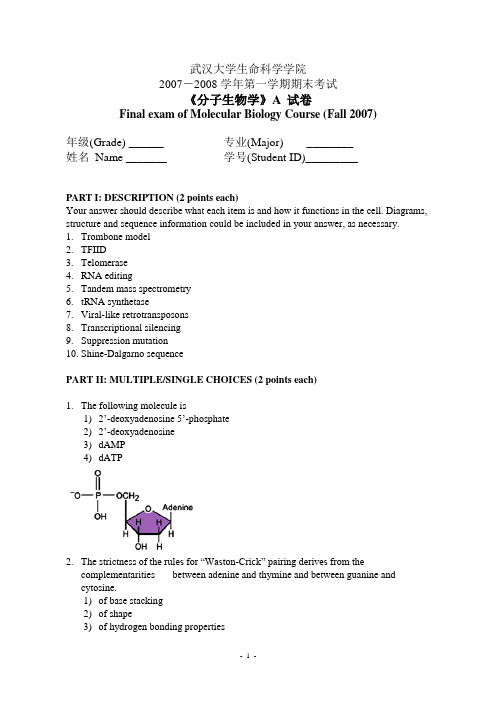
武汉大学生命科学学院2007-2008学年第一学期期末考试《分子生物学》A 试卷Final exam of Molecular Biology Course (Fall 2007)年级(Grade) ______ 专业(Major) ________姓名Name _______ 学号(Student ID)_________PART I: DESCRIPTION (2 points each)Your answer should describe what each item is and how it functions in the cell. Diagrams, structure and sequence information could be included in your answer, as necessary.1.Trombone model2.TFIID3.Telomerase4.RNA editing5.Tandem mass spectrometry6.tRNA synthetase7.Viral-like retrotransposons8.Transcriptional silencing9.Suppression mutation10.Shine-Dalgarno sequencePART II: MULTIPLE/SINGLE CHOICES (2 points each)1.The following molecule is ____1)2’-deoxyadenosine 5’-phosphate2)2’-deoxyadenosine3)dAMP4)dATP2.The strictness of the rules for “Waston-Crick” pairing derives from thecomplementarities___ between adenine and thymine and between guanine andcytosine.1)of base stacking2)of shape3)of hydrogen bonding properties4)of size3.Which of the following statements correctly describe the difference between DNA andRNA? ____1)The major groove of the regular DNA double helical structure is rich in chemicalinformation.2)RNA contains deoxyribose and uracil.3)All RNAs are single-stranded while DNA is double-stranded.4)Some RNAs can fold up into complex tertiary structures, and function asenzymes.4.Nucleosomes are the building blocks of chromosomes, which of the followingstatements are CORRECT in describing the structure and function of nucleosome? ___1)The nucleosome is composed of a core containing eight histone proteins and theDNA (~147 bp) wrapped around them.2)The core histones specifically contact the major groove of the DNA.3)The interaction of DNA with the histone octamer is very stable and cannot bealtered unless during DNA replication.4)Nucleosome remodeling by the action of enzymes such as histone acetylase isvery important for gene expression.5.Which of the following statements regarding genomes of living organism is NOTcorrect? ___1)Genome size is roughly related to the complexity of the organism.2)The number of genes in a genome cannot explain the complexity of the organism.3)The average number of introns per gene increases with the organism complexity.4)The gene density (genes/Mb) increases with the organism complexity.6.The fact that most amino acids are specified by multiple codons is known as:___1)The “wobble” phenomenon.2)The universality of the genetic code.3)Codon bias.4)The anticodon hypothesis.5)The redundancy of the genetic code.7.Which of the following repair mechanisms is involved in repair of the damaged DNAwith a double-stranded break?1)Base excision repair2)Nucleotide excision repair3)Translesion repair4)RecBCD pathway repair5)Mismatch repair8.Which of the following factors/elements regarding translation are CORRECT?1)Ribosome binding site (RBS) is essential for the translation initiation in bacterialand eukaryotic cells.2)The p olyA tail in the 3’ end of an mRNA promotes the efficient recycling ofribosomes, and therefore the translational efficiency.3)Ribosome is able to discriminate between correctly or incorrectly charged tRNAs.4)The translocation factor EF-G mimics a tRNA molecule so as to displace thetRNA bound to the A site.5)The ribosome is a ribozyme because the large rRNA is responsible for thepeptidyl transferase activity.9.RNA polymerase III is the eukaryotic enzyme responsible for:1)Transcription of ribosomal RNA.2)Transcription of transfer RNA and other small RNA species.3)Transcription of messenger RNA.4)Initiation of Okazaki fragment synthesis in DNA replication.10To obtain the sequence of a genome, which of the following steps are required? __1)Obtain a genomic library2)Obtain a cDNA library3)Shotgun sequencing on automated sequencers4)Sequence assembly on computers5)BLAST searchPART III: SHORT QUESTIONS (CHOOSE SIX QUESTIONS TO ANSWER) (5 points each, total of 30 points)1.Who is your favorite scientist among those introduced in this course? Please describehis/her research achievement and contribution to the molecular biology knowledge that you’ve learned and how his/her experience influences your research attitude.2.How the transcription of an mRNA is terminated in eukaryotic cells?3.Please describe the similarity and difference between group II intron andspliceosome-mediated pre-mRNA splicing.4.What are the general principles of transcription regulation in both prokaryotic andeukaryotic cells?5.Please give an example to demonstrate that the RNA secondary structure can regulategene expression in bacteria.Example 1: The attenuation regulation of the tryptophan operon.Example 2: Ribo-switch regulation6.How the activators and repressors regulate gene expression in eukaryotic cells?7.The following DNA sequence contains a small open reading frame (ORF) whichencodes only 5 amino acids. Please list the 5 genetic codons and the stop codon of the ORF. Which strand of the DNA (upper or lower strand) is the template for RNAtranscription? The promoter of the gene is in the right or left side of the sequence?5’ TCATGCTAGACACGTAATAGCATATGGGA –3’3’ AGTACGATCTGTGCATTATCGTATACCCT –5’PART IV: MAJOR QUESTIONS (10 points each, total of 30 points)1.Please discuss what you have learned from this course, including (1) the generalknowledge framework, (2) your most interested knowledge and why this knowledge has impressed you, (3) the value of teamwork, (4) any change of your learningattitude and/or the construction of your interest in science.2.Please discuss the similarity and difference between miRNA and siRNA, and describethe distinct contributions of these two small regulatory RNAs to the fundamentalbiology and application, respectively.3.It has been recently reported that a new protein X functions in repressing thetranscription of an oncogene gene Y. Could you design experiments to test if Xprotein binds to the promoter region of Y gene (1) in vitro and (2) in vivo? If it does bind, could you design an experiment to test if the binding is essential for thetranscriptional repression?[Notes: You have all DNA sequences, plasmid vectors, cloning enzymes and other reagents that he needs.]武汉大学生命科学学院2007-2008学年第一学期期末考试《分子生物学》试卷及参考答案Final exam of Molecular Biology Course (Spring 2008)PART I:1.Trombone modelThis model is proposed to explain the coordinated synthesis of the leading strand and the lagging strand to the direction of the repl ication folk movement at a replication folk (2’)2.TFⅡDA transcription factor composed of TBP and TAFs for RNA polymeraseⅡ;(1’)TBP recognizes TA TA box and TBP-DNA complex provides a platform for other transcription factors and polymerase to the promoter;(1’)Two of TAFs bind the core promoter elements such as Inr and DPE. Several of histone-like TAFs are also associated with some histone modification enzymes.(1’)3. Telomerase:Solve the End Replication Problem (1’) through adding the telomeric sequence to the 3’ end of the telomere. (1’) No extra primer nor template needed.4. RNA editing: a way of changing the sequence of RNA after transcription(1’) by site-specific deamination of insertion.(1’)5. Tandem mass spectrometryAnswer 1: A method that determines the protein sequence based on the accurate mass of protein fragments obtained by mass spectrometry (2’)Answer 2: (2’)6.Aminoacyl tRNA synthetaseAn enzyme that catalyzes the attachment of an amino acid to a cognate tRNA (2’) through two steps: adenylylation of amino acid and tRNA charging (+1’)7. Viral-like retrotransposons: also called long terminal reapeat (LTR) retrotransposons. The element includes two long terminal repeat sequences that flank a region encoding two enzymes: integrase and reverse transcriptase. It mediate transposition reaction through a RNA intermediate.8Transcriptional silencing is a specialized form of repression that can spread along chromatin,(1’) switching off multiple genes without the need for each to bear binding sites for specific repressors(1’). The mechanism of this repression is the propagation of certain repressing histone modifications over stretches of chromatin. (1’)Insolator elements can block this spreading, thus protect some inserted gene from si lencing.(0.5’) 9. Suppressor Mutation: 抑制突变,抑制基因突变,抑制因子突变Key points: (1) a second mutation(2) the GENOTYPE is mutationally altered but the wild type PHENOTYPE restores(1)maybe on a different gene (intergenetic) or on the same gene (intragenetic)10. Shine-Dalgarno sequence: 又称RBS, ribosome binding siteKey points: (1) in prokaryotic cells(2) a stretch of RNA 3 to 9 nucleosides upstream of the start codon in a mRNA(3) contains conservative sequence: 5’-AGGAGG-3’, which is complimented to certain region of 16s rRNA(2)the conservation and spacing decides the activeness of the following OFRPart III: Short questions2Each mRNA gene contains a poly-A signal sequence near the termination site(1’). Eukaryotic transcription termination is highly coupled with polyad enylation:(1’)(1)CstF/CPSF bound at the CTD tail is transferred to poly-A signal sequence after ti istranscripted, resulting in mRNA cleavage and recruitment of enzymes for polyadenylation .(2’)(2)Poly-A polynerase(PAP) adds about 200 As to RNA’s 3’ end.(2’)Two models for polymerase recycle:(3)Transfer of 3’-processing enzymes from CTD tail to RNA triggers comformational change inPol, reduce processivity, leading to spontaneous termination.(0.5’)(4)Absense of 5’-cap is sensed by the Pol, recognizes the transcript as improper andterminates.(0.5’)3.Please describe the similarity and difference between group II intron and spliceosome-mediatedpre-mRNA splicing.(答案有点长,大家可以在精简一下。
武汉大学《分子生物学》复习题库及答案
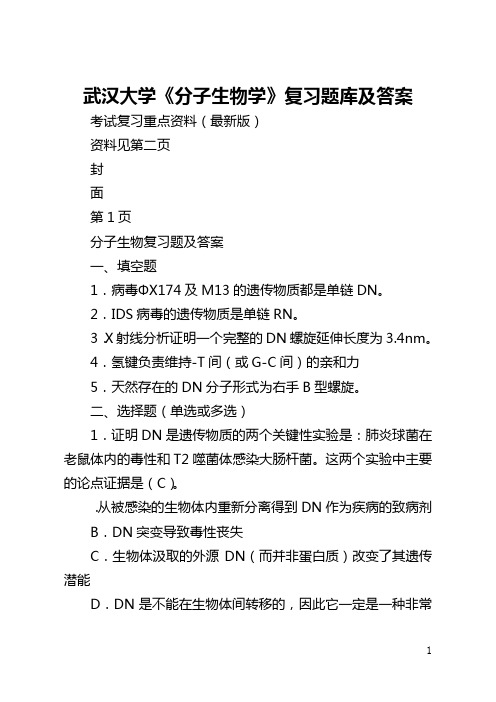
武汉大学《分子生物学》复习题库及答案考试复习重点资料(最新版)资料见第二页封面第1页分子生物复习题及答案一、填空题1.病毒ΦX174及M13的遗传物质都是单链DN。
2.IDS病毒的遗传物质是单链RN。
3.X射线分析证明一个完整的DN螺旋延伸长度为3.4nm。
4.氢键负责维持-T间(或G-C间)的亲和力5.天然存在的DN分子形式为右手B型螺旋。
二、选择题(单选或多选)1.证明DN是遗传物质的两个关键性实验是:肺炎球菌在老鼠体内的毒性和T2噬菌体感染大肠杆菌。
这两个实验中主要的论点证据是(C)。
.从被感染的生物体内重新分离得到DN作为疾病的致病剂B.DN突变导致毒性丧失C.生物体汲取的外源DN(而并非蛋白质)改变了其遗传潜能D.DN是不能在生物体间转移的,因此它一定是一种非常保守的分子E.真核心生物、原核生物、病毒的DN能相互混合并彼此替代2.1953年Wtson和Crick提出()。
.多核苷酸DN链通过氢键连接成一个双螺旋B.DN的复制是半保留的,常常形成亲本-子代双螺旋杂合链C.三个连续的核苷酸代表一个遗传密码D.遗传物质通常是DN而非RNE.分离到回复突变体证明这一突变并非是一个缺失突变3.DN双螺旋的解链或变性打断了互补碱基间的氢键,并因此改变了它们的光汲取特性。
以下哪些是对DN的解链温度的正确描述?(C、D).哺乳动物DN约为45℃,因此发烧时体温高于42℃是十分危险的B.依赖于-T含量,因为-T含量越高则双链分开所需要的能量越少C.是双链DN中两条单链分开过程中温度变化范围的中间值D.可通过碱基在260nm的特征汲取峰的改变来确定E.就是单链发生断裂(磷酸二酯键断裂)时的温度4.DN的变性(、C、E)。
.包括双螺旋的解链B.可以由低温产生C.是可逆的D.是磷酸二酯键的断裂E.包括氢键的断裂5.在类似RN这样的单链核酸所表现出的“二级结构”中,发夹结构的形成(、D)。
.基于各个片段间的互补,形成反向平行双螺旋B.依赖于-U含量,因为形成的氢键越少则发生碱基配对所需的能量也越少C.仅仅当两配对区段中所有的碱基均互补时才会发生D.同样包括有像G-U这样的不规则碱基配对E.同意存在几个只有提供过量的自由能才能形成碱基对的碱基6.DN分子中的超螺旋(、C、E)。
2017年武汉大学885分子生物学考研真题
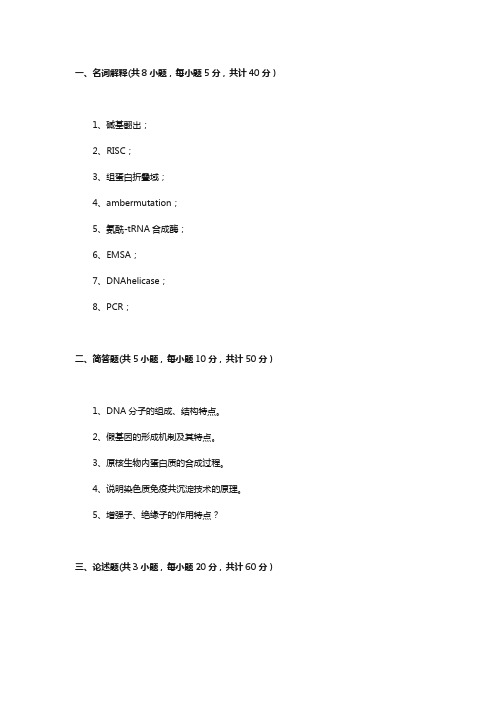
一、名词解释(共8小题,每小题5分,共计40分)
1、碱基翻出;
2、RISC;
3、组蛋白折叠域;
4、ambermutation;
5、氨酰-tRNA合成酶;
6、EMSA;
7、DNAhelicase;
8、PCR;
二、简答题(共5小题,每小题10分,共计50分)
1、DNA分子的组成、结构特点。
2、假基因的形成机制及其特点。
3、原核生物内蛋白质的合成过程。
4、说明染色质免疫共沉淀技术的原理。
5、增强子、绝缘子的作用特点?
三、论述题(共3小题,每小题20分,共计60分)
1、一个基因在人体正常组织内编码出来的蛋白质大小为50kDa,但在人的乳腺癌组织内编码的两种蛋白质的大小分别为50kDa、40kDa,研究发现该基因含有五个外显子,其中四号外显子编码90个氨基酸(大小约为10kDa),因此猜想这种现象是由于可变剪切引起,设计实验证明你的猜想。
2、简述真核生物转录因子的特点,描述一种根据此特点而产生的一种分子生物学技术,并介绍其作用。
3、增强子和绝缘子在基因表达调控中的作用和特点有哪些?
885分子生物学初试参考书目
《Molecular biology of the gene》(原版)(第六版)PEARSON出版此书有中文翻译版,也可作为参考
《现代分子生物学》(第三版)(朱玉贤)。
武汉大学分子生物学真题2001-2014汇总.

一.解释概念(20分,每个4分)卫星DNA 复制体逆转座子反式激活因子衰减子与衰减作用三、问答题(50分)1. 说出双链DNA复制起始有关的五种重要的酶或蛋白并简述它们的功能。
(15分)2. 简述增强子的特点和性质及作用机制。
(10分)3. 简述真核RNA聚合酶II的转录起始复合物装配过程和转录起始(15分)4. DNA限制性内切酶EcoRI是人们熟悉的常用内切酶,它是在大肠杆菌(E.coli)R株中发现的,它被广泛用于分子克隆操作和DNA分析。
pUC质粒是常用克隆载体之一,它的多克隆位点上有EcoRI、BamHI、KpnI、HindIII等酶切点。
假如要你把一段由EcoRI切割产生的外源DN**段克隆到pUC质粒中,并把重组质粒转化大肠杆菌R株来扩增,已知条件是所用的R菌株中只有EcoRI一种限制性内切酶,你设计如何做才能确保成功?为什么?(10分)武汉大学2002分子生物学三.问答:1.简述(或绘图说明)真核细胞RNA聚合酶II转录的起始需要哪些基本转录因子及其装配过程(15分)2.简述(或绘图说明)色氨酸操纵子弱化的机制(15分)3.在讨论基因家庭时经常提到胚胎、胎儿和成体形成的蛋白质,这些述语是指什么现象?可用什么术语来描述这一类基因家族(5分)4. 你正在进行Southern blot分析,并刚刚完成凝胶电泳部分,下一步是将胶浸泡在NaOH溶液中使DNA变性为单链,为了节约时间,你跳过这一步,直接把DNA 从胶上转到硝酸纤维素膜上,你将标记好的探针与膜杂交,却发现放射自显影结果是一片空白,哪里错了呢?(5分)一、下列名词翻译成中文,并简要解释1、Domains and motifs2、Alternative splicing3、Reporter genes4、The PCR cycle5、Restriction mapping6、Multiple cloning sites7、DNA libraries8、Proteomics9、Replicon10、Semi-conservative replication二、简答题(共5题,每题8分,共40分)1、请列举三种以上蛋白质纯化技术,并说明不同纯化技术的简单原理。
武汉大学分子生物学题库1

GLOSSARYAbundance of an mRNA is the average number of molecules per cell.Abundant mRNAs consist of a small number of individual species, each present in a large number of copies per cell.Acceptor splicing site—see right splicing junction.Acentric fragment of a chromosome (generated by breakage) lacks a centromere and is lost cell division.Acrocentric chromosome has the centromere located nearer one end than the other.Active site is the restricted part of a protein to which a substrate binds.Allele is one of several alternative forms of a gene occupying a given locus on a chromosome. Allelic exclusion describes the expression in any particular lymphocyte of only one allele coding for the expressed immunoglobulin.Allosteric control refers to the ability of an interaction at one site of a protein to influence the activity of another site.Alu family is a set of dispersed, related sequences, each~300 bp long, in the human genome. The individual members have Alu cleavage sites at each end (hence the name).Alu-equivalent family is the set of sequences in a mammalian genome that is related to the human Alu family.α-Amanitin is a bicyclic octapeptide derived from the poisonous mushroom Amanita phalloides; it inhibhits transcription by certain eukaryotic RNA polymerases, especially RNA polymerase II.Amber codon is the nucleotide triplet UAG, one of three codons that cause termination of protein synthesis.Amber mutaion describes any change in DNA that creates an amber codon at a site previously occupied by a codon representing an amino acid in a protein.Amber suppressors are mutant genes that code for tRNAs whose anticodons have been altered so that they can respond to UAG codons as well as or instead of to their previous codons.Aminoacyl-tRNA is transfer RNA carrying an amino acid; the covalent linkage is between the NH2group of the amino acid and either the 3’-or-2’-OH group of the terminal base of the tRNA.Aminoacyl-tRNA synthetases are enzymes responsible for covalently linking amino acids to the 2’ or 3’-OH position of tRNA.Amphipathic structures have two surfaces, one hydrophilic and one hydrophobic. Lipids are amphipathic; and some protein regions may form amphipathic; and some protein regions may form amphipathic helices, with one charged face and one neutral face.Amplification refers to the production of additional copies of a chromosomal sequence,1found as intrachromosomal or extrachromoxomal DNA.Anchorage dependence describes the need of normal eukaryotic cells for a surface to attach to in order to grow in culture.Aneuploid chromosome constitution differes from the usal diploid constitution by loss or duplication of chromosomes or chromosomal segments. Annealing is the pairing of complementary single strands of DNA to form a double helix.Antibody is a protein (immunoglobulin) produced by B lymphocyte cells that recognizes a particular foreign ‘antigen,’and thusw triggers the immune res ponse.Anticoding strand of duples DNA is used as a template to direct the synthesis of RNA that is complementary to it.Antigen is any molecule whose entry into an organism provokes synthesis of an antibody (immunoglobulin).Antiparallel strands of the d ouble helix are organized in opposite orientation, so that the 5’ end of one strand is aligened with the 3’ end of the other strand.Antitermination proteins allow RNA polymerase to transcribe through certain terminator sites.Ap endonucleases make incisio ns in DNA on the 5’ side of either apurinic or apyrimidinc sites.Apoinducer is a protein that binds to DNA to switch on transcription by RNA polymerase. Archebacteria comprise a minor line of prokaryotes, and may have introns in the genome. Ascus of a fungus contains a tetrad or octad of the (haploid) spores, representhing the products of a sihngle meiosis.att sties are the loci on a phage and the bacterial chromosome at which recombination integrates the phage into. or excises it from , the bacterial chromosome.Attenuation describes the regulation of termination of transcription that is involved in controlling the expression of some bacterial operons.Attenuato r is the terminator sequence at which attenuatioj occurs.Autogenous conhtrol describes the action of a gene product that either inhibits (negative autogenous control) or activates (positive autogenous control) expression of the gene coding for it.Autonomous controlling element in maize is an active transposon with the ability to transpose (cf nonautonomous controlling element).Autoradiography detects radioactively labeled molecules by their effect in creating an image on pholtographic film.Autosomes are all the chromosomes except the sex chromosomes; a diploid cell has two copies of each autosome.Blymphocytes (or B cells) are the cells responsible for synthesizing antibodies.2Backcross is another (earlier) term for a testcross.Back mutation reverses the effect of a mutation that hand inactivated a gene; thus it restores wild type.Bacteriophages are viruses that infect bacteria; often abbreviated as phages.Balbaini ring is an extremely large puff at a band of a polytene chromosome.Bands of polytene chromosomes are visible as dense regions that contain the majority of DNA;bands of normal chromosomes are relatively much larger and are generated in the form of regions that retain a stain on certain chemical treatments.Base pair (bp) is a partnership of A with T or of C with G in a DNA double helix; other pairs can be formed in RNA under certain circumstances.Bidirectional replication is accomplished when two replication forks move away from the same origin in different directions.Bivalent is the structure containing all four chromatids (two representing each homologue) at the start of meiosis.Blastoderm is a stage of insect embryogenesis in which a layer of nuclei or cells around the embryo surround an internal mass of yolk.Blocked reading frame cannot be translated into protein because it is interrupted by termination codons.Blunt-end ligation is a reaction that joins two DNA duplex molecules directly at their ends. bp is an abbreviation for base pairs; distance along DNA is measured in bp.Branch migration describes the ability of a DNA strand partially paired with its complement in a duplex to extend its pairing by displacing the resident strand with which it is homologous. Breackage and reunion describes the mode of genetic recombination, in which two DNA duplex molecules are broken at corresponding points and then rejoined crosswise (involving formation of a length of heteroduplex DNA around the site of joining).Buoyant desity measures the ability of a substance to float in some standard fluid, for example, CsCl.C banding is a technique for generating stained regions around centromeres.C genes code for the constant regions of immunoglobulin protein chains.C value is the total amount of DNA in a haploid genome.CAAT box is part of a conserved sequence located upstream of the startpoints of eukaryotic transcription units; it is recognized by a large group of transcription factors.Cap is the structure at the 5’ end of eukaryotic mRNA, introduced after transcripton by linking the terminal phosphate of 5’ GTP to the terminal base of the mRNA. The added G (and sometimes some other bases) are methylated, giving a structure of the form 7Me G5’ppp 5’Np…3CAP(CRP)is a positive regulator protein activated by cyclic AMP. It is needed for RNA polymerase to initiate transcription of certain (catabolitesensitive) operons of E. coli.Capsid is the external protein coat of a virus particle.Catabolite repression describes the decreased expression of many bacterial operons that results from addition of glucose. It is caused by a decrease in the level of cyclic AMP, which in turn inactivates the CAP regulator.cDNA is a single-stranded DNA complementary to an RNA, synthesized from it by reverse transcription in vitro.cDNA clone is a duplex DNA sequence representing an RNA, carried in a cloning vector. Cell cycle is the period from one division to the next.Cell hybrid is a somatic cell containing chromosomes derived from parental cells of different species (e.g. a man-mouse somatic cell hybrid), generating by fusing the cells to form a heterokaryon in which the nuclei subsequently fused.Centrioles are small hollow cylinders consisting of microtubules that become located near the poles during mitosis. They reside within the centrosomes.Centromere is a constricted region of a chromosome that includes the site of attachment to the mitotic or meiotic spindle (see also kinetochore).Centrosomes are the regions from which microtubules are organized at the poles of a mitotic cell. In animal cells, each centrosome contains a pair of centrioles surrounded by a dense amorphous region to which the microtubules attach. See also MTOC.Molecular chaperone is a protein that is needed for the assembly or proper folding of some other protein, but which is not itself a component of the target complex.Chemical complexity is the amount of a DNA component measured by chemical assay.Chi sequence is an octamer that provides a hotspot for RecA-mediated genetic recombination in E. coli.Chi structure is a joint between two duplex molecules of DNA revealed by cleaving an intermediate of two joined circles to generate linear ends in each circle. It resembles a Greek chi in outline, hence the name.Chiasma (pl. chiasmata)is a site at which two homologous chromosomes appear to have exchanged material during meiosis.Chromatids are the copies of a chromosome produced by replication. The name is usually used to describe them in the period before they separate at the subsequent cell division. Chromatin is the complex of DNA and protein in the nucleus of the interphase cell. Individual chromosomes cannot be distinguished in it .It was originally recognized by its reaction with stains specific for DNA.Chromocenter is an aggregate of heterochromatin from different chromosomes. Chromomeres are densely staining granules visible in chromosomes under certain conditions, especially early in meiosis, when a chromosome may appear to consist of a series of4chromomeres.Chromosome is a discrete unit of the genome carrying many genes. Each chromosome counsists of a very long molecule of duplex DNA and an approximately equal mass of proteins. It is visible as a morphological entity only during cell division.Chromosome walking describes the sequential isolation of clones carrying overlapping sequences of DNA, allowing large regions of the chromosome to be spanned. Walking is often performed in order to reach a particular locus of interest.cis-acting locus affects the activity only of DNA sequences on its own molecule of DNA; this property usually implies that the locus does not code for protein.cis-acting protein has the exceptional property of acting only on the molecule of DNA from which it was expressed.cis configuration describes two sites on the same molecule of DNA.cis/trans test assays the effect of relative configuration on expression of two mutations. In a double heterozygote, two mutations in the same gene show mutant phenotype in trans configuration, wild-type in cis configuration.Cistron is the geneti unit defined by the cis/trans test; equivalent to gene ib comprising a unit of DNA representing a protein.Class switching is a change in the expression of the c cregion of an immunoglobulin heavy chain during lymphocyte differentiation.Clone describes a large number of cells or molecules identical with a single ancestral cell or molecule.Cloning vector is a plasmid or phage that is used to ‘carry’ inserted foreign DNA for the purposes of producing more material or a protein product.Closed reading frame contains termination codons that prevent its translation into protein. Coated vesicles are vesicles whose membrane has on its surface a layer of the protein clathrin.Coconversion is the simultaneous correction of two sites during gene conversion.Coding strand of DNA has the same sequence as mRNA.Codominant alleles both contribute to the phenotype; neither is dominant over the other. Coevolution —see concerted evolution.Cognate tRNAs are those recognized by a particular aminoacy-tRNA synthetase. Coointegrate structure is produced by fusion of two replicons, one originally possessing a transposon, the other lacking it; the cointegrate has copies of the transposon present at both junctions of the replicons, oriented as directrepeats.Cold-sensitive mutant is defective at low temperature but functional at normal temlperature. Colony hybridization is a technique for using in situ hybridization to identify bacteria carrying chimeric vectors whose inserted DNA is homologous with some particular sequence. Compatibility group of plasmids contains members unable to coexist in the same bacterial5cell.Complementation refers to the ability of independent (nonallelic)genes to provide diffusible products that produce wild phenotype when two mutants are tested in trans configuration in a heterozygote.In vitro complementation assay consists of identifying a component of a wid-type cell that can confer activity on an extract prepared from a mutant cell. The assay identifies the component rendered inactive by the mutation.Complementation group is a series of mutations unable to complement when tested in pairwise combinations in trans; defines a genetic unit (the cistron) that might better be called a noncomplex mentation group.Complex locus (of D. melanogaster) has genetic properties inconsistent with the function of a gene representing a single protein. Complex loci are usually very large (>100kb) at the molecular level.Complexity is the total length of different sequences of DNA present in a given preparation. Compostie transposons have a central region flanked on each side by insertion sequences, either or both of which may enable the entire element to transpose.Concatemer of DNA consists of a series of unit genomes repeated in tandem. Concatenated circles of DNA are interlocked like rings one a chain.Concerted evolution describes the ability of two related genes to evolve together as though constituting a single locus.Condensation reaction is one in which a covalent bond is formed with loss of a water molecule, as in the addition of an amino acid to a polypeptide chain.Conditional lethal mlutations kill a cell or virus under certain (nonpermissive) conditions, but allow it to survive under other (permissive) conditions.Conjugation describes ‘mathing’ between two bacterial cells, when (part of ) the chromosome is transferred from one to the other.Consensus sequence is an idealized sequence in which each position represents the base most often found when many actual sequences are compared.Conservative recombination involves breakage and reunion of preexisting strands of DNA without any synthesis of new stretches of DNA.Conservative transposition refers to the movement of large elements, originally classified as transposons, but now considered to be episomes. The mechanism of movement resembles that of phage lambda.Constant regions of immunoglobulins are coded by C genes and are the parts of the chain that vary least. Those of heavy chains identify the type of immunoglobulin.Constitutive genes are expressed as a function of the interaction of RNA polymerase with the promoter, without additional regulation; sometimes also called household genes in the context of describing functions expressed in all cells at a low level.67Constitutive heterochromatin describes the inert state of permanently nonexpressed sequences, usually satellite DNA.Constitutive mutations cause genes that usually are regulated to be expressed without regulation.Contractile ring is a ring of actin filaments that forms around the equator at the end of mitosis and is responsible for pinching the daughter cells apart.Controlling elements of maize are transposable units originally identified solely by their genetic properties. They may be autonomous (able to transpose independently) or nonautonomous (able to element).Coordinate regulation refers to the common control of a group of genes.Cordycepin is 3’ deoxyadenosine, an inhibitor of poly adenylation of RNA.Core DNA is the 14.6 bp of DNA contained on a core particle.Core particle is a digestion product of the nucleosome that retains the histone octamer and has 14.6 bp of DNA; its structure appears similar to that of the nucleosome itself.Corepressor is a small molecule that triggers repression of transcription by binding to a regulator protein.Cosmids are plasmids into which phage lambda cos sites have been inserted; as a result, the plasmid DNA can be packaged in vitro in the phage coat.Cot is the product of DNA concentration and time of incubation in a reassociation reaction. Cot 21 is the Cot required to proceed to half completion of the reaction; it is directlyproportional to the unique length of reassociating DNA.Cotransfection is the simultaneous transfection of two markers.Crossing-over describes the reciprocal exchange of material between chromosomes that occurs during meiosis and is responsible for genetic recombination.Crossover fixation refers to a possible consequence of unequal crossing-over that allows a mutation in one member of a tandem cluster to spread through the whole cluster (or to be eliminated).Cruciform is the structure produced at inverted repeats of DNA if the repeated sequence pairs with its complement on the same strand (instead of with its regular partner in the other strand of the duplex).Cryptic satellite is a satellite DNA sequence not identified as such by a separate peak on a density gradient; that is, it remains present in main-band DNA.ctDNA is chloroplast DNA.Cyclic AMP (cAMP) is a molecule of AMP in which the phosphate group is joined to both the 3’ and 5’ positions of the ribose; its binding activates the CAP, a postive regulator of prokaryotic transcription.Cyclins are proteins that accumulate continuously throughout the cell cycle and are thendestroyed by proteolysis during mitosis. (see also MPF).Cytokinesis is the final process involved in separation and movement apart of daughter cells at the end of mitosis.Cytological hybridization—see in situ hybridization.Cytoplasm describes the material between the plasma membrane and the nucleus. Cytoplasmic inheritance is a property of genes located in mitochondria or chloroplasts (or possibly other extranuclear organelles).Cytoplasmic protein synthesis is the ranslation of mRNAs representing nuclear genes; it occurs via ribosomes attached to the cytoskeleton.Cytoskeleton consists of networks of fibers in the cytoplasm of the eukaryotic cell.Cytosol describes the general volume of cytoplasm in which organelles ( such as the mitochondria ) are located.D loop is a region within mitochondrial DNA in which a short stretch of RNA is paired with one strand of DNA, displacing the orignal partner DNA strand in this region. The same term is used also to describe the displacement of a region of one strand of duplex DNA byu a single-stranded invader in the reaction catalyzed by RecA protein.Degeneracy in the genetic code refers to the lack of an effect of many changes in the third base of the codon on the amino acid that is represented.Deletions are generated by removal of a sequence of DNA, the regions on either side being joined together.Denaturation of DNA or RNA describes its conversion from the double-stranded to the singlestranded state; separation of the strands is most often accomplished by heating. Denaturation of protein describes its conversion from the physiological conformation to some other (inactive) conformation.Derepressed state describes a gene that is turned on. It is synonymous with induced when describing the normal state of a gene; it has the same meaning as constitutive in describing the effect of mutation.Dicentric chromosome is the product of fusing two chromosome fragments, each of which has a centromere. It is unstable and may be broken when the two centromeres are pulled to opposite poles in mitosis.Diploid set of chromosomes contains two copies of each autosome and two sex chromosome. Direct repeats are identical (or related) sequences present in two or more copies in the same orientation in the same molecule of DNA; they aer not necessarily adjacent.Discontinuous replication refers to the synthesis of DNA in short (Okazaki) fragments that are later joined into a continuous strand.Disjunction describes the movement of members of a chromosome pair to opposite poles during cell division. At mitosis and the second meiotic division, disjunction applies to sister8chromatids; at first meiotic division it applies to sister chromatid pairs.Divergence is the percent difference in nucleotide sequence between two related DNA sequences or in amino acid sequences between two proteins.Divergent transcription refers to the intitiation of transcription at two promoters facing in the opposite direction, so that transcription proceeds away in both directions from a central region.dna mutants of bacteria are temperature-sensitive; they cannot synthesize DNA at 42℃, but can do so at 37℃.DNAase is an enzyme that attacks bonds in DNA.DNA-driven bybridization involves the reaction of an excess of DNA with RNA.DNA polymerase is an enzyme that synthesizes a daughter strand(s) of DNA (under direction from a DNA template). May be involved in repair or replication.DNA replicase is a DNA-synthesizing enzyme required specifically for replication.Domain of a chromosome may refer either to a discrete structural entity defined as a region within which supercoiling is independent of other domains; or to an extensive region including an expressed gene that has heightened sensitivity to degradation by the enzyme DNAase I.Domain of a protein is a discrete continuous part of the amino acid sequence that can be equated with a particular function.Dominant allele determines the phenotype displayed in a heterozygote with another (recessive) allele.Donor splicing site—see left splicing junction.Down promoter mutations decrease the frequency of initiaton of transcription. Downstream identifies sequences proceeding farther in the direction of expression, for example, the conding region is downstream of the initiation condon.Early development refers to the period of a phage infection before the start of DNA replication.Extopic expression describes the expression of a gene in a tissue in which it is not usually expressed; for example, in a transgenic animal.Elongation factors (EF in prokaryotes, eEF in eukaryotes) are proteins that associate with ribosomes cyclically, during addition of each amino acid to the polypeptide chain.End labeling describes the addition of a radioactively labeled group to one end (5’ or 3’) of a DNA strand.End-product inhibition describes the ability of a product of a metabolic pathway to inhibit the activity of an enzyme that catalyzes an early step in the pathway.Endocytosis is a process by which proteins at the surface of the cell are internalized, being transported into the cell within membranous vesicles.9Endocytic vesicles are membranous particles that transport proteins through endocytosis; also known as clathrin-coated vesicles.Endonucleases cleave bonds within a nucleic acid chain; they may be specific for RNA or for singlestranded of double-stranded DNA.Endoplasmic reticulum is a highly convoluted sheet of membranes, extending from the outer layer of the nuclear envelope into the cytoplasm.Enhancer element is a cis-acting sequence that increases the utilization of (some) eukaryotic promoters, and can function in either orientation and in any location (upstream or downstream) relative to the promoter.Envelopes surround some organelles (for example , nucleus or mitochondrion) and consist of concentric membranes, each membrane consisting of the usual lipid bilayer.Epigenetic changes influrence the phenotype without altering the genotype. They consist of changes in the properties of a cell that are inherited but that do not represent a change in genetic information.Episome is a plasmid able to integrate into bacterial DNA.Epistasis describes a situation in which expression of one gene wipes out the phenotypic effects of another gene.Essential gene is one whose deletions is lethal to the organism (see also lethal locus). Established cell lines consist of eukaryotic cells that have been adapted to indefinite growth in culture (they are said to be immortalized).Eubacteria comprise the major line of prokaryotes.Euchromatin comprises all of the genome in the interphase nucleus except for the heterochromatin.Evolutionary clock is defined by the rate at which mutations accumulate in a given gene. Excision-repair systems remove a single-stranded sequence of DNA containing damaged or mispaired bases and replace it in the duplex by synthesizing a sequence complementary to the remaining strand.Exocytosis is the process of secreting proteins from a cell into the medium, by transport in membranous vesicles from the endoplasmic reticulum, through the Golgi, to storage vesicles, and finally (upon a regulatory signal) through the plasma membrane.Exocytic vesicles (also secretory vesicles) are membranous particles that transport and store proteins during excytosis.Exon is any segment of an interrupted gene that is represented in the mature RNA product. Exonucleases cleave nucleotides one at a time from the end of a polynucleotide chain; they may be specific for either the 5’ or 3’ end of DNA or RNA.Expression vector is a cloning vector desined so that a coding sequence inserted at a particular site will be transcribed and translated into protein.Extranuclear genes reside outside the nucleus in organelles such as mitochondria and10chloroplasts.F factor is a bacterial sex or fertility plasmid.F1 generation is the first generation produced by crossing two parental (homozygous) lines. Facultative heterochromatin describes the inert state of sequences that also exist in active copies—for example, one mammalian X chromosome in females.Fast component of a reassociation reaction is the first to reature and contains highly repetitive DNA.Fate map is a map of an embryo showing the adult tissues that will develop from the descendants of cells that occupy particular regions of the embryo.Figure eight describes two circles of DNA linked together by a recombination event that has not yet been completed.Filter hybridization is performed by incubating a deatured DNA preparation immobilized on a nitrocellulose filter with a solution of radioactively labeled RNA or DNA.Fingerprint of DNA is a pattern of polymorphic restriction fragments that differ between individual genomes.Fingerprint of a protein is the pattern of fragments (usually resolved on a two dimensional electrophoretic gel) generated by cleavage with an enzyme such as trypsin.Fluidity is a property of membranes; it indicates the ability of lipids to move laterally within their particular monolayer.Focus formation describes the ability of transformed eukaryotic cells to grow in dense clusters, piled up on one another.Focus forming unit (ffu) is a quantitative measure of forcus formation.Foldback DNA consists of inverted repeats that have renatured by intrastrand reassociation of denatured DNA.Foot printing is a technique for identifying the site on DNA bound by some protein by virtue of the protection of bonds in this region against attack by nucleases.Forward mutations inatctivate a wild-type gene.Founder effect refers to the presence in a population of many individuals all with the same chromosome (or region of a chromosome) derived from a single ancestor.Frameshift mutations arise by deletions or insertions that are not a multiple of 3bp; they change the frame in which triplets are translated into protein.G banding is a technique that generates a striated pattern in metaphase chromosomes that distinguishes the members of a haploid set.G1 is the period of the eukaryotic cell cycle between the last mitosis and the start of DNA replication.G2 is the period of the eukaryotic cell cycle between the end of DNA replication and the start11。
分子生物武大考研试题

笔试题(满分100分)1. PCR的条件是什么?设置的条件有什么依据?2. 去离子水与蒸馏水是否相同,若相同,为什么?不相同,又是为什么?3. 关于菌株保存有以下两个方案(1)不加甘油逐渐降温后,然后保存在-80℃中,(2)加甘油直接保存在-80℃中。
分别分析两种方案是否正确,若正确,为什么?不正确,又是为什么?(3)菌株保存中,甘油的作用是什么?依据是什么?4. 高压灭菌的温度为多少?灭菌是为什么要排尽灭菌锅内的冷空气?5. 克隆所用的载体有哪些必要的结构?6. 电泳分离DNA所用的缓冲液pH为多少?此时DNA带什么电荷,为什么?7. 电泳分离DNA、RNA、蛋白质分别用什么染色?8. 现有100uLDNA水溶液(装在eppendorf管中),请设计一个实验沉淀DNAWuda武大---考试方法说明及各章课外思考题一、课程的学习与考试作为生命科学领域的专业基础课,本课程强调学生对微生物学基本理论、基本概念、基本实验原理及微生物基本实验操作的掌握与运用,鼓励学生在教学过程中对教学的积极参与和平时学习的积累,不鼓励期末突击复习、考试的投机学习行为。
为此,特制定期末总成绩的评定标准。
一)理论课期末考试卷面成绩占总成绩的55%,其余45%为平时成绩。
平时成绩包括:1、课后思考题(0~4分),每章均会根据教学内容布置思考题,要求按时上交,教师每次将随机抽查20%~30%的作业本进行评分,在学期末考试结束后,作业本全部上交作为评定平时成绩的依据。
2、学习笔记(0~4分),要求并鼓励课堂记录或课后整理学习内容,所有学习笔记在期末考试结束后上交作为评定平时成绩的依据。
3、参与教学活动(0~17分),主要是鼓励学生在学习过程中的主动学习能力,在课堂、网站论坛或与教师平时就学习问题的探讨将作为此项成绩评定的依据。
为了配合这项工作,论坛中的同步教学论坛只有在经过认证后方可发言,是对同学参与教学活动项目评定的主要依据。
(完整版)分子生物学试题及答案
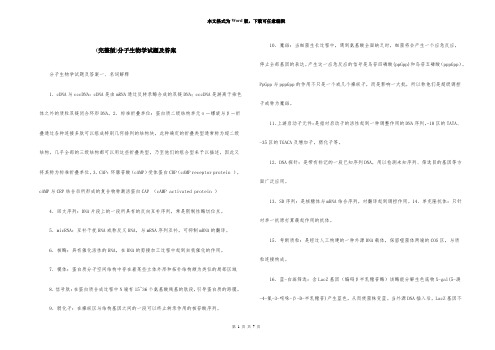
三、简答 1.分别说出 5 种以上 RNA 的功能? 转运 RNA tRNA 转运氨基酸 核蛋白体 RNA rRNA 核蛋白体组成成 信使 RNA mRNA 蛋白质合成模板 不均一核 RNA hnRNA 成熟 mRNA 的前体 小核 RNA snRNA 参加 hnRNA 的剪接 小胞浆 RNA scRNA/7SL-RNA 蛋白质内质网定位合成的信号识别体的组成成分 反义 RNA anRNA/micRNA 对基因的表达起调整作用 核酶 Ribozyme RNA 有酶活性的 RNA 2.原核生物与真核生物启动子的主要差别? 原核生物 TTGACA --- TATAAT------起始位点-35 -10 真核生物
蝶呤对叶酸还原酶有抑制作用,因此不能生长。骨-脾融合细胞:在 HAT 中能生长,脾细胞可 以利用次黄嘌呤,骨细胞供应细胞分裂功能。
6、利用双脱氧末端终止法(Sanger 法)测定 DNA 一级结构的原理与方法? 原理是采纳核苷酸链终止剂—2,,3,-双脱氧核苷酸终止 DNA 的延 长。由于它缺少形成 3/5/磷酸二脂键所需要的 3-OH,一旦参入到 DNA 链中,此 DNA 链就 不能进一步延长。依据碱基配对原则,每当 DNA 聚合酶需要 dNMP 参入到正常延长的 DNA 链中 时,就有两种可能性,一是参入 ddNTP,结果导致脱氧核苷酸链延长的终止;二是参入 dNTP,
7、激活蛋白(CAP)对转录的正调控作用? 环腺苷酸(cAMP)受体蛋白 CRP(cAMP receptor protein),cAMP 与 CRP 结合后所形成 的复合物称激活蛋白 CAP (cAMPactivated protein )。当大肠杆菌生长在缺乏葡萄糖的培 育基中时,CAP 合成量增加,CAP 具有激活乳糖(Lac)等启动子的功能。一些依靠于 CRP 的 启动子缺乏一般启动子所具有的典型的-35 区序列特征(TTGACA)。因此 RNA 聚合酶难以与其 结合。CAP 的存在(功能):能显著提高酶与启动子结合常数。主要表现以下二方面: ①CAP 通过转变启动子的构象以及与酶的相互作用关心酶分子正确定向,以便与-10 区结 合,起到取代-35 区功能的作用。 ②CAP 还能抑制 RNA 聚合酶与 DNA 中其它位点的结合,从而提高与其特定启动子结合的概 率。
武汉大学历年分子生物学考研真题

武汉大学分子生物学历年考研真题 (2001年-2013年)武汉大学2001 年攻读硕士学位研究生入学考试试题科目名称:分子生物学科目代码: 477注意:所有答题内容必须写在答题纸上,凡写在试题和草稿纸上的一律无效。
一、解释概念 (20 分,每个4分)1. 卫星 DNA2. 复制体3. 逆转座子4. 反式激活因子5. 衰减子与衰减作用二:填空(30 分,每空 1 分,请将答案写在答卷上)1.从病毒到高等生物的研究表明,遗传物质是。
2.冈崎片段的发现证实了双链 DNA的复制,在复制过程中,一条新生链的合成是的,称为链;而另一条链的合成是的,称为链。
3.大肠菌中有三种DNA聚合酶,其中的polI的作用是 ,而pol III的作用是。
pol I和pol III都有的三种活性是、、。
4.由于真核细胞染色体DNA的复制要有一段RNA为引物,因此线状的DNA复制后必须存在着5’端缩短的问题。
已发现有一种端粒蛋白称为 ,它由构成,可以使单链DNA的5’延长。
5.对DNA 损伤有几种修复系统 ,其中只有修复系统可以造成DNA变异,与这一系统有关的一套基因平时受到一称为的抑制蛋白所抑制,它发挥抑制作用是结合在一段约20bp长的称为的DNA序列上,当DNA损伤时,另一种蛋白质称为。
把这种抑制蛋白水解后,修复系统的基因才会被激活。
6.真核细胞中有三种依赖于DNA的RNA聚合酶分别合成不同的RNA,RNA pol I 负责合成,RNA pol II 负责合成,RNA pol III负责合成。
7.大分子互相作用是分子生物学的重要内容,包括蛋白质之间、蛋白质与DNA或RNA之间的互相作用,蛋白质有四种重要的结构花式与大分子互相作用有关, 这些结构花式是 , , 。
8.NO 是气体小分子信号,它可由脱氨产生,它的作用方式是直接与酶作用使产生cGMP(环式GMP)。
9.真核mRNA的5’端通常有帽子结构,3’端有 polyA。
在polyA上游有一保守序列称为polyA 信号,其序列为。
武汉大学分子生物学真题2009年_真题-无答案

武汉大学分子生物学真题2009年(总分150,考试时间90分钟)一、名词翻译与解释1. Regulatory gene2. Real-time PCR3. Nick translation4. Generic promoter5. Histone code6. Proteomics7. Gene targeting8. Single nucleotide polymorphism9. Alternative mRNA processlng10. Replicon二、简答题1. 什么是DNA损伤?生物体DNA损伤与哪些因素有关?生物细胞有哪些机制来处理DNA 损伤,并进行DNA损伤修复?2. 表观遗传(epi-genetics)修饰包括哪些内容?并举一例说明其在基因的表述调控和染色体重塑等方面有哪些重要作用?3. 反式作用因子是直接或间接地识别或结合在各类顺式作用元件序列上而参与调控靶基因转录效率的蛋白质。
试问反式作用因子的DNA结合结构域有哪几种类型?特点如何?反式作用因子,即转录调控因子,是一类特殊的DNA结合蛋白。
不同的转录调控因子能与DNA上特异的顺式作用元件相互作用从而调控转录。
这些因子中的重要功能结构域有:螺旋一转角一螺旋,锌指结构,碱性亮氨酸拉链,螺旋一环一螺旋、同源域等,转录因子的磷酸化对转录调控起很大作用。
4. PCR的原理是什么?在PCR反应中是否循环次数越多,所合成产物数量也越多?为什么?5. 增强子和绝缘子在基因表达调控中的作用和特点有哪些?三、论述题1. 试论述转座子的类别、结构和转座机制及在基因表达与分子进化中的作用。
2. 在进行遗传重组和基因克隆与表达的研究中,对分子克隆的载体与宿主系统的选择有非常重要的作用。
请论述各主要载体系统的特点及宿主系统。
3. 从转录后水平上进行比较,论述原核生物和真核生物RNA加工的异同点。
转录后水平上的RNA加工即mRNA的加工。
4. 什么是HapMap计划、ENCODE计划、Jim计划、Proteome计划?这些计划与人类基因组计划有何联系?这些计划对分子生物学的发展和生命活动的分子机制有什么影响和意义?。
武汉大学2013至2014学年第一学期分子生物学期末考试试题

武汉大学2013至2014学年第一学期分子生物学期末考试试题《分子生物学》试卷Final exam of Molecular Biology Course (Spring 2014)年级______ 专业________ 学号_________ 姓名_______成绩______PART I: DESCRIPTION (2 points each)Your answer should describe what each item is and how it functions in the cell. Diagrams, structure and sequence information should be included in your answer, as necessary.1. Yeast artificial chromosome2. RNA interference3. Proteomics4. Shine-Dalgarno sequence5. Alternative splicing6. Ribozyme7. r-dependent termination8. RNA editing9. DNA lesions10. Protein targetingPART II: MULTIPLE CHOICES (1 points each)Select the one best answer for each question.1. The catalytic activity for peptide bond formation (the peptidyl transferase activity) is located in the:1) RNA of the large ribosomal subunit.2) leader sequence of the messenger RNA.3) RNA of the small ribosomal subunit.4) proteins of the small ribosomal subunit.5) proteins of the large ribosomal subunit.2. Bidirectional and semi-conservative are two terms that refer to:1) transcription.2) translation.3) replication.4) all of the above.5) none of the above.3. The fact that most amino acids are specified by multiple codons is known as:1) the “wobble” phenomenon.2) the universality of the genetic code.3) codon bias.4) the anticodon hypothesis.5) the redundancy of the genetic code.4. RNA polymerase I is the eukaryotic enzyme responsible for:1) transcription of ribosomal RNA.2) transcription of transfer RNA and other small RNA species.3) transcription of messenger RNA.4) initiation of Okazaki fragment synthesis in DNA replication.5. Restriction enzymes can cleave DNA that is either single-stranded or double-stranded, as longas it contains the appropriate recognition site.1) True 2) False6. Information about the sequence of the coding region of a gene is best obtained from:1) a YAC clone.2) a genomic clone.3) a cDNA clone.4) the protein.7. A chromatography method that can be used specifically to purify proteins based on their chargeis:1) gel filtration chromatography.2) ion-exchange chromatography.3) DNA affinity chromatography.4) antibody affinity chromatography.8. A nonsense mutation is a change in the DNA sequence that results in:1) a small deletion or insertion.2) an amino acid change in the protein encoded by the gene.3) a premature stop codon.4) all of the above.5) none of the above.9. A protein complex involved in degradation of proteins within the cell is known as the:1) ubiquitin/proteasome system.2) molecular chaperone.3) chaperonin.4) ribosome.5) Krebs/TCA cycle.10. ___binds to the repressor and turn on the transcription of the structural genes in the Lac operon.1) cAMP2) lactose3) allolactose4) CRP11. Which of the following RNA species is involved in degradation of the mRNA containing complementary sequence1) miRNA2) siRNA3) tRNA4) 5S RNA5) U3 snRNA12. The genome sequencing projects are confirming the theory that genome size is directlyproportional to the number of genes contained within that genome. In other words, a genome that is 10 times as big will contains approximately 10 times as many protein coding genes.1) True 2) False13. HeLa cells, derived from a human cervical carcinoma, are able to propagate indefinitely inculture and are therefore known as a(n):1) tissue culture.2) tumor.3) transgenic cell line.4) immortalized cell line.14. E. coli cells are smaller than yeast cells.1) True 2) False15. Which of the following domains is not a DNA binding domain1) Proline-rich domains2) Helix-turn helix domains3) Zinc finger domains4) Basic domains16. The aminoacyl-tRNA synthetases distinguish between about 40 different shaped tRNA molecules in the cells.1) True 2) FalsePART III: SHORT QUESTIONS (8 points each)1. How do bacterial replication start and accomplished. Remember to include theproteins/enzymes and important DNA sequence involved in this process.2.Design experiments to clone a yeast gene and express this gene in yeast.3. Below is the multiple cloning site (MCS) of the plasmid vector pUC18 and theN-terminal and C-terminal sequence of protein X. Note that the MCS constitutes a part of the LacZ open reading frame. Suppose that you are going to clone the protein X gene into pUC18, so that your target gene is transcribed under the control of LacZ promoter, and translated with the LacZ gene to produce a fusion protein. You are requested to use Bam HI and Pst I to the clone X gene, please add these restriction sites on the corresponding position of the X gene. Remember to maintain the reading frame of the X gene with the LacZ gene 4.(1) MCS of pUC18Eco RI Sac I Kpn I Sma I Bam HI Xba I Sal I Pst IACG AAT TCG AGC TCG GTA CCC GGG GAT CCT CTA GAG TCG ACC TGC AGG CAT GCAThr Asn Ser Ser Ser Val Pro Gly Asp Pro Leu Glu Ser T hr Cys Arg His Ala(2) N-terminal sequenceX gene. ATG ACC CCU CAU AAC…Met Thr Pro His Asn Gly Asp…(3) C-terminal sequence of X gene. …GAU AGU ACA GCU GCC AAG TAA…Asp Ser Thr A la Ala LysPART IV: MAJOR QUESTIONS (201:Please describe how an mRNA gene is transcribed, processed and translated in human cells. What are the possible mechanisms in regulating the expression of this gene?2 (20 points): A bacterium is found to metabolize a rare sugar produced by a plant that the bacteria grow on. However, the bacteria prefer glucose as the energy source. The problem is, if you want to finish this course with a satisfied score, you must figure out the regulatory mechanism that the bacteria used to determine the sugar choice.The gene involving in the rare sugar metabolism has been identified as fun3. You can use northern blot to analyze the expression of fun3and use DNA footprinting to analyze the binding of proteins to the control elements of fun3gene. The following table shows the experimental resultsQuestions:1. Please propose a mechanism to explain the above results. You should focus onthe question “How does the expression of fun3gene is tightly regulated so that it is only highly expressed when the rare sugar is the only carbon source”. You must answer what proteins A, B and C are. (8 points)2. How is protein A regulated? (2 points)(1) glucose turns the repressor on(2) glucose turns the repressor off(3) the rare sugar turns the repressor on(4) the rare sugar turns the repressor off3. How is protein C regulated? (2 points)(1) glucose turns the activator on(2) glucose turns the activator off(3) the rare sugar turns the activator on(4) the rare sugar turns the activator off4. How could you make the bacteria always use the rare sugar as the energy source even in the presence of glucose? (8 points)武汉大学生命科学学院2013-2014学年第一学期期末考试《分子生物学》试卷及参考答案Final exam of Molecular Biology Course (Spring 2014)写在参考答案前面的话:Ø该课程考试目的是考查学生对所学知识掌握的情况,除选择题外,其他题目的答案基本都不是唯一的。
分子生物学武汉大学历年试题(截至2022)

分子生物学武汉大学历年试题(截至2022)●实验设计题●分离基因、鉴定功能——PCR、电泳;敲除、高表达●验证核酸蛋白互作——ESMA、ChIP、DNA足迹法、酵母双杂交●大量表达基因/蛋白——基因工程:强启动子/诱导启动子、高拷贝质粒、偏爱密码子●选择实验原理+扩写●2001●名解●卫星DNA●复制体●逆转座子●反式激活因子●衰减子与衰减作用●问答●说出双链DNA复制起始有关的五种重要的酶或蛋白并简述它们的功能。
(15 分)●简述增强子的特点和性质及作用机制。
(10分)●简述真核RNA聚合酶II的转录起始复合物装配过程和转录起始 (15分)●DNA限制性内切酶EcoRI是人们熟悉的常用内切酶,它是在大肠杆菌(E.coli)R株中发现的,它被广泛用于分子克隆操作和DNA分析。
pUC质粒是常用克隆载体之一,它的多克隆位点上有EcoRI、BamHI、KpnI、HindIII 等酶切点。
假如要你把一段由EcoRI切割产生的外源DNA段克隆到 pUC 质粒中,并把重组质粒转化大肠杆菌R株来扩增,已知条件是所用的R菌株中只有EcoRI一种限制性内切酶,你设计如何做才能确保成功?为什么?(10分)●2002●问答●简述(或绘图说明)真核细胞RNA聚合酶II转录的起始需要哪些基本转录因子及其装配过程(15分)●简述(或绘图说明)色氨酸操纵子弱化的机制(15分)●在讨论基因家庭时经常提到胚胎、胎儿和成体形成的蛋白质,这些述语是指什么现象?可用什么术语来描述这一类基因家族(5分)●你正在进行 Southern blot 分析,并刚刚完成凝胶电泳部分,下一步是将胶浸泡在NaOH溶液中使DNA变性为单链,为了节约时间,你跳过这一步,直接把DNA 从胶上转到硝酸纤维素膜上,你将标记好的探针与膜杂交,却发现放射自显影结果是一片空白,哪里错了呢?(5分)●2003●名解●Domains and motifs 结构域与基序●Alternative splicing 选择性剪接●Reporter genes 报告基因●The PCR cycle 聚合酶链式反应循环●Restriction mapping 限制酶切图谱●Multiple cloning sites 多克隆位点●DNA libraries DNA文库●Proteomics 蛋白质组学●Replicon 复制子●Semi-conservative replication 半保留复制●简答●请列举三种以上蛋白质纯化技术,并说明不同纯化技术的简单原理。
- 1、下载文档前请自行甄别文档内容的完整性,平台不提供额外的编辑、内容补充、找答案等附加服务。
- 2、"仅部分预览"的文档,不可在线预览部分如存在完整性等问题,可反馈申请退款(可完整预览的文档不适用该条件!)。
- 3、如文档侵犯您的权益,请联系客服反馈,我们会尽快为您处理(人工客服工作时间:9:00-18:30)。
2002年三、问答:1、简述(或绘图说明)真核细胞RNA聚合酶II转录的起始需要哪些基本转录因子及其装配过程(15分)2、简述(或绘图说明)色氨酸操纵子弱化的机制(15分)3、在讨论基因家庭时经常提到胚胎、胎儿和成体形成的蛋白质,这些述语是指什么现象?可用什么术语来描述这一类基因家族(5分)4、你正在进行Southern blot分析,并刚刚完成凝胶电泳部分,下一步是将胶浸泡在NaOH溶液中使DNA变性为单链,为了节约时间,你跳过这一步,直接把DNA从胶上转到硝酸纤维素膜上,你将标记好的探针与膜杂交,却发现放射自显影结果是一片空白,哪里错了呢?(5分)2001年三、问答题(50分)1.说出双链DNA复制起始有关的五种重要的酶或蛋白并简述它们的功能。
(15分)2.简述增强子的特点和性质及作用机制。
(10分)3.简述真核RNA聚合酶II的转录起始复合物装配过程和转录起始(15分)4. DNA限制性内切酶EcoRI是人们熟悉的常用内切酶,它是在大肠杆菌(E.coli)R株中发现的,它被广泛用于分子克隆操作和DNA分析。
pUC质粒是常用克隆载体之一,它的多克隆位点上有EcoRI、BamHI、KpnI、HindIII等酶切点。
假如要你把一段由EcoRI切割产生的外源DNA片段克隆到pUC质粒中,并把重组质粒转化大肠杆菌R株来扩增,已知条件是所用的R菌株中只有EcoRI一种限制性内切酶,你设计如何做才能确保成功?为什么?(10分)2003年分子生物学一。
下列名词翻译成中文,并简要解释4*101.Domains and motifs2. Alternative splicing3.Reporter genes4. The PCR cycle5.Restriction mapping6.Multiple cloning sites7.DNA libraries8.Proteomics9.Replicon10. semi-conservative replication二。
简答题8*5 总计40分1. 请列举三种以上的蛋白质纯化技术,并说明不同技术的简单原理。
2. 说说DNA损伤与DNA突变之间的区别和相互关系。
3. 简述密码的简并性(degeneracy)和同义密码子(synonymous codon)及其在生物上的重要性。
4. 简述原核生物转录起始与转录终止过程中涉及到的主要蛋白质和核酸结构及其具体作用。
5. 简述cDNA文库的构建过程。
三。
问答题(1-4每题15,5题10,总计70)1. 人类基因组计划完成的社会意义和科学意义是什么?2. 什么是操纵子(operon)?试说明色氨酸操纵子(Trp operon)在原核基因表达调控中的调控机制和重要作用。
3. 简要解释顺式作用元件与反式作用因子,并举二例说明他们的相互作用方式。
4. 试说明真核细胞与原核细胞在基因转录,翻译及DNA的空间结构方面存在的主要差异,表现在哪些方面?5. 限制性核酸内切酶有哪几种类型?哪一种类型的限制酶最适合于基因工程,为什么?请简要说明理由。
2004年武汉大学硕士研究生入学考试分子生物学试卷一名词翻译与解释1synonymous codons2RNA editing3Spliceosome4Microarray5Plaque hybridization6Open reading frame7Ribozyme8RFLP9Site specific recombination10RNA interference二简答题(共5小题,每小题10分,共50分)1简述真核生物rRNA基因,tRNA 基因和mRNA基因的转录机制。
2原核生物和真核生物中存在哪些类型的转座子?其转座机制有那些?3简述真核生物DNA复制中,端粒复制与染色体其他部分DNA复制的异同和生物学意义。
4原核生物的蛋白质合成可分为哪些阶段?简述各阶段的主要事件。
5列举4种可用来检测,鉴定转基因动,植物的分子生物学技术和方法,简述选择这些技术的理由。
三论述题1试述环境因素对DNA的损伤以及生物体中存在的DNA损伤修复系统。
如果DNA损伤没有被修复会造成什么后果?2试比较真核生物RNA聚合酶Ⅱ识别的启动子与原核生物RNA聚合酶所识别的启动子的结构特点,各结构单元的功能是什么?为什么原核生物一种RNA聚合酶能识别不同的结构基因?3在进行基因工程时,载体是携带靶DNA片段进入宿主细胞进行扩增和表达的工具,请问一个载体应具有哪些基本特性和结构特点?4人类基因组计划基本完成表明:人类基因组约有3乘10的9次方bp(而大肠杆菌的基因组约为4。
6乘10的6次方bp),其中仅有百分之一的基因组DNA 直接编码蛋白质,约有百分之二十四的基因组DNA为内含子,而百分七十五的基因组DNA为其他非编码序列。
试从(1)传代中遗传信息的保持;(2)基因表达调空的角度来论述人类基因组如此排列的可能生物学意义。
2005分子试题一(4/10)1 Ubiquitin2 ribosomal binding site3 siRNA miRNA4 proteome5 DNA foot printing6 single nucleotide polymorphism7 chromosome walking8 haplotype9 zoo blot10 transcription unit二(5/10)1简述真核细胞rRNA tRNA 和mRNA转录使用的聚合酶及各RNA前体(precursor)加工的基本过程?2 研究表明蛋白质组比基因组更复杂,蛋白质组中存在的蛋白质数目比基因组中存在的基因数目要多许多,这是如何造成的,你如何解释这种现象?3 简述原核与真核细胞染色体结构的差别4 在分子生物学研究中经常用各种载体进行研究工作,试问有哪些不同大小类型的载体,各自的主要特点是什么?5 简述DNA损伤修复的机制,在什么情况下DNA损伤会引起DNA突变?三()4/151蛋白质与核酸的相互作用存在于基因表达的各个水平上,请分别举例说明在基因复制RNA转录和蛋白质翻译过程中二者的相互作用。
2 一个真核细胞的蛋白质编码基因有哪些结构元件(或组建)组成(包括各种调控元件)?请画图表示,并说名各元件的功能与作用?3 请设计一组试验来(1)克隆一个你所感兴趣的人类基因(2)并对基因产物大量表达与纯化(3)然后研究该基因的生物学功能4 生命科学的研究已进入后基因组时代,试从“分子生物学”的角度来谈谈你对后基因组时代的认识,并预测后基因组时代里“分子生物学”发展的未来2006年分子生物学一、名解4*101、DNA Microarray2、Spliceosome3、Cosmid vector4、Proteasome5、Zinc finger domain6、DNase I hypersensitivity7、Insulator8、Post-transcriptional gene silencing9、Reverse transcription PCR10、Missense mutation二、简答题10*51、简述microRNA 的基因调控功能与机制。
2、简述染色体端粒复制的问题,人正常细胞和癌细胞的端粒复制有何不同?3、真核生物基因组中含有几种类型的DNA序列?你如何设计实验来证明?4、简述RNA编辑(RNA editing)的机制及其对基因表达的影响。
5、下面的DNA序列中含有一个假象基因,编码仅5个氨基酸。
请写出这些氨基酸的密码子以及终止密码子,并指出RNA转录的模版是哪条链?启动子在该序列左侧还是右侧?5-TCATGCTAGACACGTAATAGCATATGGGA-33-AGTACGATCTGTGCATTATCGTATACCCT-5三、论述题15*41、论述一个真核基因产生有功能的蛋白质需要经过哪些分子生物学工程(event)?列出每个过程发生的细胞位置和参与的主要酶和蛋白因子。
2、有哪几种类型的遗传重组?其重组的特点如何?3、DNA的甲基化在遗传信息的传递、DNA复制和DNA损伤修复等过程中有什么重要意义?请举例说明。
4、假如你进入实验室开始研究一个小鼠DNA结合蛋白的生物学功能:(1)、请设计实验确定其编码基因在小鼠细胞内的表达水平?(2)、请设计实验确定该蛋白的那个结构域具有DNA结合功能?(3)、如何确定该蛋白在小鼠体内(in vivo)的生物学功能。
2007年攻读硕士学位研究生入学考试试题科目:分子生物学科目代码:475一、名词翻译与解释(共10小题,每小题4分,共40分)1、Transcriptome2、Translesion replication3、Riboswitch4、Synonymous mutation5、Tandem gene cluster6、Frameshift7、Nucleosome positioning8、Non-autonomous transposon9、Holliday junction10、Polymerase switching二、简答题(共5小题,每小题10分,共50分)1、试从DNA和RNA结构的不同解释为什么DNA被广泛作为遗传信息的承载者?RNA在细胞内行使哪些功能?2、什么是蛋白质组?什么是蛋白质组学?如何理解高等生物细胞中一个基因组可以产生多少个蛋白质组?3、什么是解旋酶(helicase) ?请设计实验并画设计图证明一个DNA解旋酶是具有3’→5’还是5’→3’解旋活性?4、论述原核生物基因表达调控的主要策略,并举例进行详细说明?5、核糖体是蛋白质合成的主要机器。
请问原核生物有哪些亚基和分子组成?核糖体在蛋白质翻译过程中有哪些功能位点?起什么作用?三、论述题(共4小题,每题15分,共60分)1、在真核生物中,成熟的mRNA序列往往与基因组DNA序列之间存在许多差异,有些序列甚至在基因组DNA上根本没有相应的互补序列。
另外,同一种基因的DNA常常会转录出多种mRNA 。
请解释并说明产生这些现象的机制及其意义。
2、真核细胞mRNA的Ⅱ型RNA聚合酶转录,需要Ⅱ型启动子和转录因子TF ⅡA ,TFⅡB ,TFⅡD ,TFⅡE 和TFⅡH等。
(1)请设计实验证明这些转录因子和RNA聚合酶Ⅱ结合到启动子的顺序;(2)请设计实验证明TFⅡD复合体可以单独准确结合到启动子TATA box上;(3)TFⅡD复合体包括哪些蛋白质?如果你有其中一个蛋白质的抗体,并知道其他几个蛋白质的大小,请设计实验验证TFⅡD复合体的组分。
3、DNA复制具有很高的准确性(accuracy)或保真度(fidelity), 出错率低于1010分之一。
请解释:(1)DNA复制过程中和复制后有哪些机制保证复制的准确性?(2)为什么RNA聚合酶的保真度比DNA复制低?(3)DNA复制的错误或突变对生物本身有何意义?4、两位美国科学家Fire博士和Mello博士在分子生物学研究领域做出了重大贡献,并因此获得了2006年度的诺贝尔生理与医学奖。
